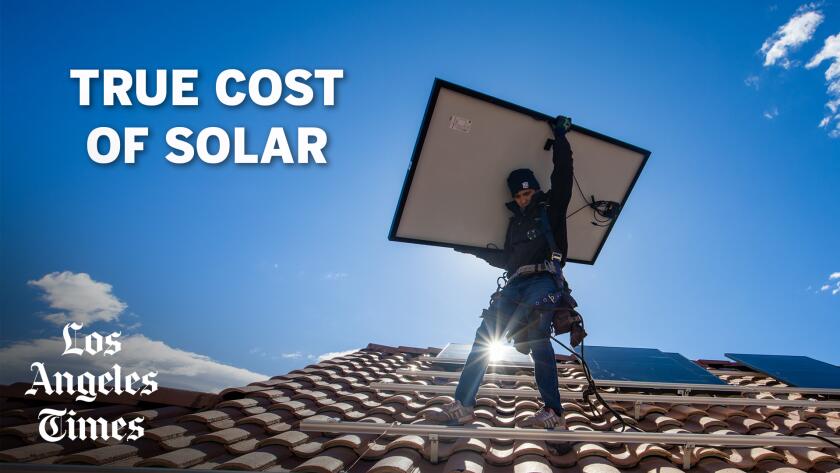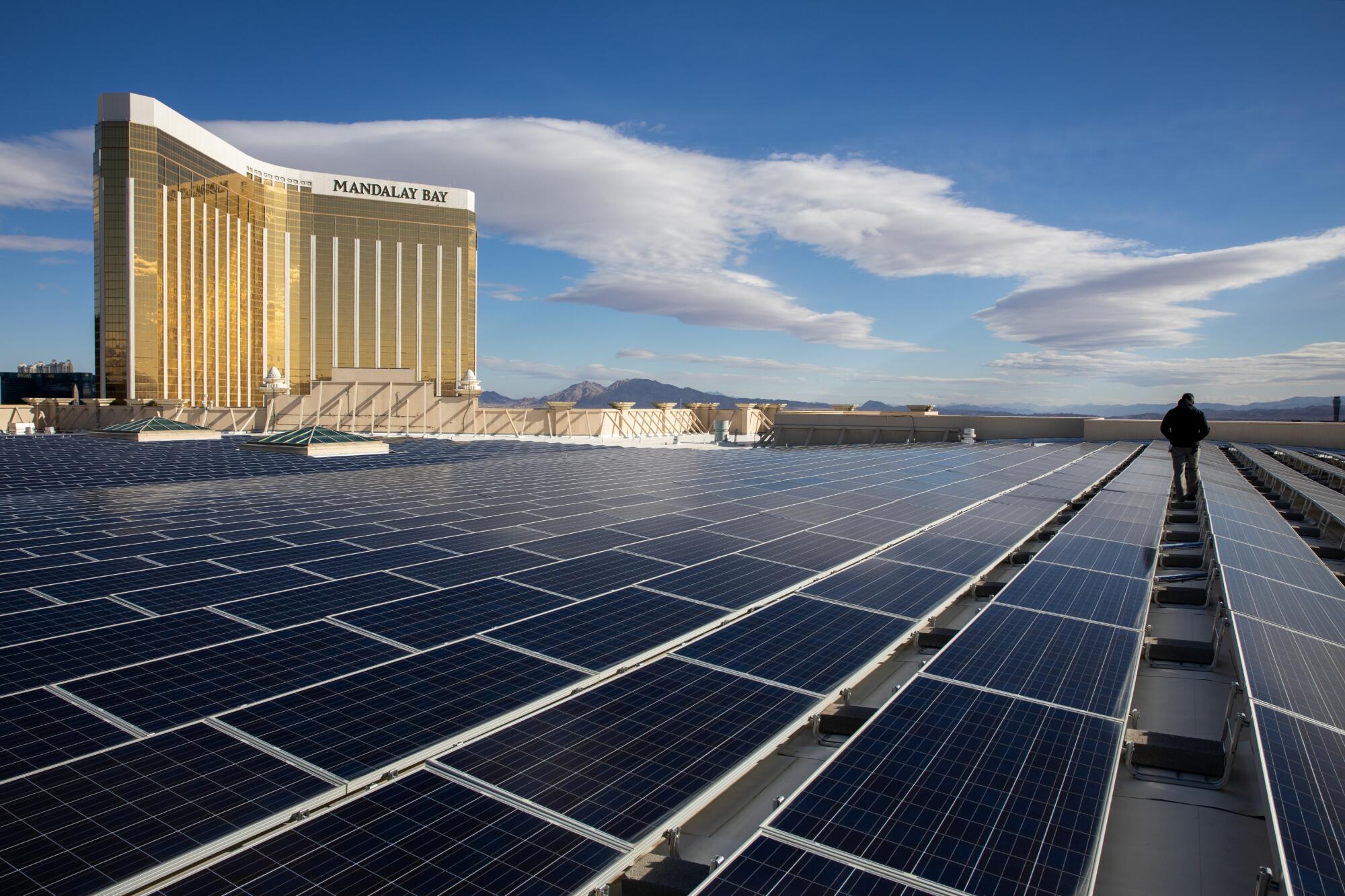
- Share via
High above the Las Vegas Strip, solar panels blanketed the roof of Mandalay Bay Convention Center — 26,000 of them, rippling across an area larger than 20 football fields.
From this vantage point, the sun-dappled Mandalay Bay and Delano hotels dominated the horizon, emerging like comically large golden scepters from the glittering black panels. Snow-tipped mountains rose to the west.
It was a cold winter morning in the Mojave Desert. But there was plenty of sunlight to supply the solar array.
“This is really an ideal location,” said Michael Gulich, vice president of sustainability at MGM Resorts International.
The same goes for the rest of Las Vegas and its sprawling suburbs.
Sin City already has more solar panels per person than any major U.S. metropolis outside Hawaii, according to one analysis. And the city is bursting with single-family homes, warehouses and parking lots untouched by solar.
- Share via
L.A. Times energy reporter Sammy Roth heads to the Las Vegas Valley, where giant solar fields are beginning to carpet the desert. But what is the environmental cost? (Video by Jessica Q. Chen, Maggie Beidelman / Los Angeles Times)
There’s enormous opportunity to lower household utility bills and cut climate pollution — without damaging wildlife habitat or disrupting treasured landscapes.
But that hasn’t stopped corporations from making plans to carpet the desert surrounding Las Vegas with dozens of giant solar fields — some of them designed to supply power to California. The Biden administration has fueled that growth, taking steps to encourage solar and wind energy development across vast stretches of public lands in Nevada and other Western states.
Those energy generators could imperil rare plants and slow-footed tortoises already threatened by rising temperatures.
They could also lessen the death and suffering from the worsening heat waves, fires, droughts and storms of the climate crisis.
Researchers have found there’s not nearly enough space on rooftops to supply all U.S. electricity — especially as more people drive electric cars. Even an analysis funded by rooftop solar advocates and installers found that the most cost-effective route to phasing out fossil fuels involves six times more power from big solar and wind farms than from smaller local solar systems.
But the exact balance has yet to be determined. And Nevada is ground zero for figuring it out.
The outcome could be determined, in part, by billionaire investor Warren Buffett.
The so-called Oracle of Omaha owns NV Energy, the monopoly utility that supplies electricity to most Nevadans. NV Energy and its investor-owned utility brethren across the country can earn huge amounts of money paving over public lands with solar and wind farms and building long-distance transmission lines to cities.
But by regulatory design, those companies don’t profit off rooftop solar. And in many cases, they’ve fought to limit rooftop solar — which can reduce the need for large-scale infrastructure and result in lower returns for investors.
Mike Troncoso remembers the exact date of Nevada’s rooftop solar reckoning.
It was Dec. 23, 2015, and he was working for SolarCity. The rooftop installer abruptly ceased operations in the Silver State after NV Energy helped persuade officials to slash a program that pays solar customers for energy they send to the power grid.
“I was out in the field working, and we got a call: ‘Stop everything you’re doing, don’t finish the project, come to the warehouse,’” Troncoso said. “It was right before Christmas, and they said, ‘Hey, guys, unfortunately we’re getting shut down.’”
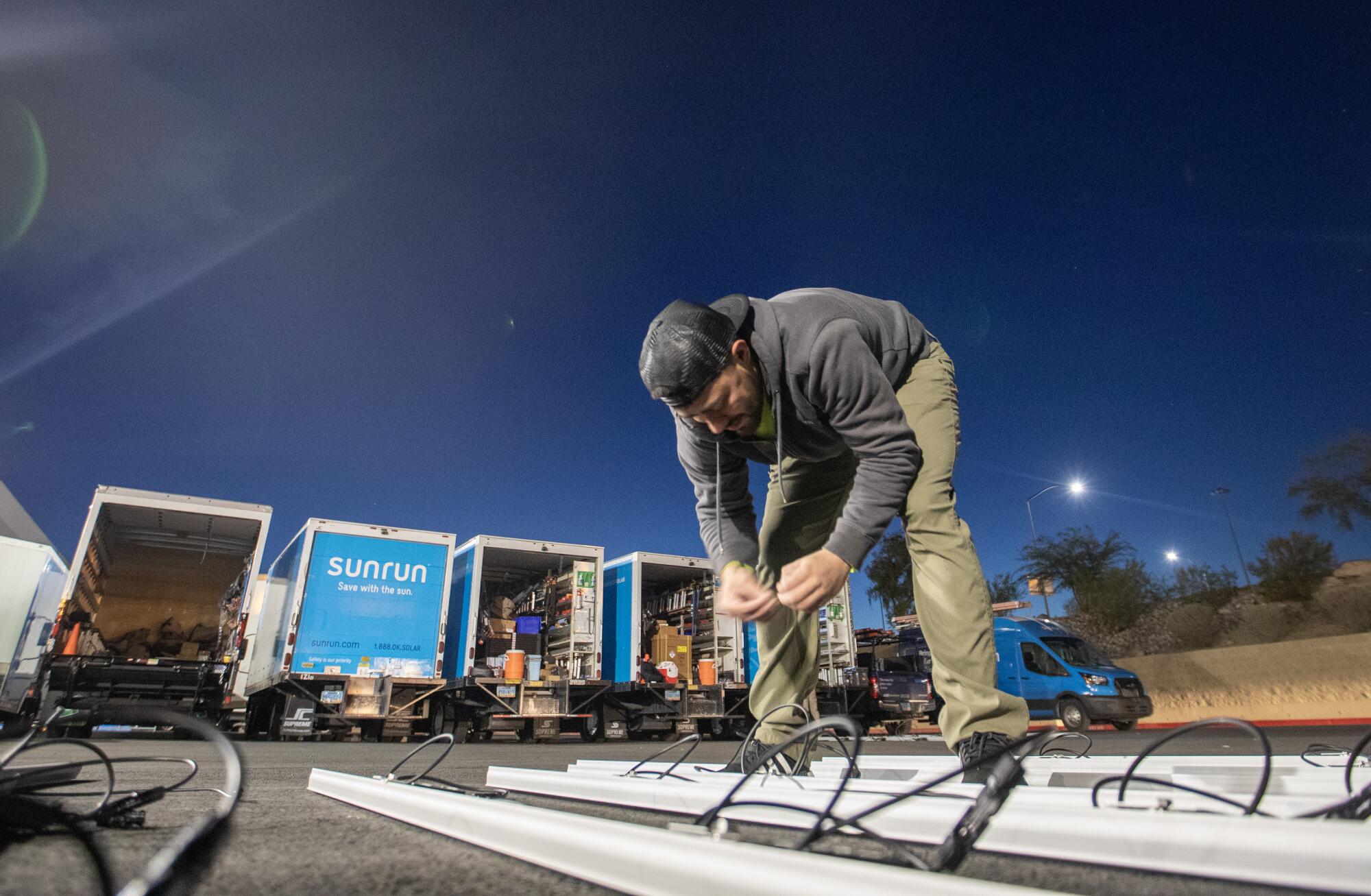
After a public outcry, Nevada lawmakers partly reversed the reductions to rooftop solar incentives. Since then, NV Energy and the rooftop solar industry have maintained an uneasy political ceasefire. Installations now exceed pre-2015 levels.
Today, Troncoso is Nevada branch manager for Sunrun, the nation’s largest rooftop solar installer. The company has enough work in the state to support a dozen crews, each named for a different casino. On a chilly winter morning before sunrise, they prepared for the day ahead — laying out steel rails, hooking up microinverters and loading panels onto powder-blue trucks.
But even if Sunrun’s business continues to grow, it won’t eliminate the need for large solar farms in the desert.
Some habitat destruction is unavoidable — at least if we want to break our fossil fuel addiction. The key questions are: How many big solar farms are needed, and where should they be built? Can they be engineered to coexist with animals and plants?
And if not, should Americans be willing to sacrifice a few endangered species in the name of tackling climate change?
To answer those questions, Los Angeles Times journalists spent a week in southern Nevada, touring solar construction sites, hiking up sand dunes and off-roading through the Mojave. We spoke with NV Energy executives, conservation activists battling Buffett’s company and desert rats who don’t want to see their favorite off-highway vehicle trails cut off by solar farms.
Odds are, no one will get everything they want.
Support our journalism
Your support helps us deliver the news that matters most. Subscribe to the Los Angeles Times.

The tortoise in the coal mine
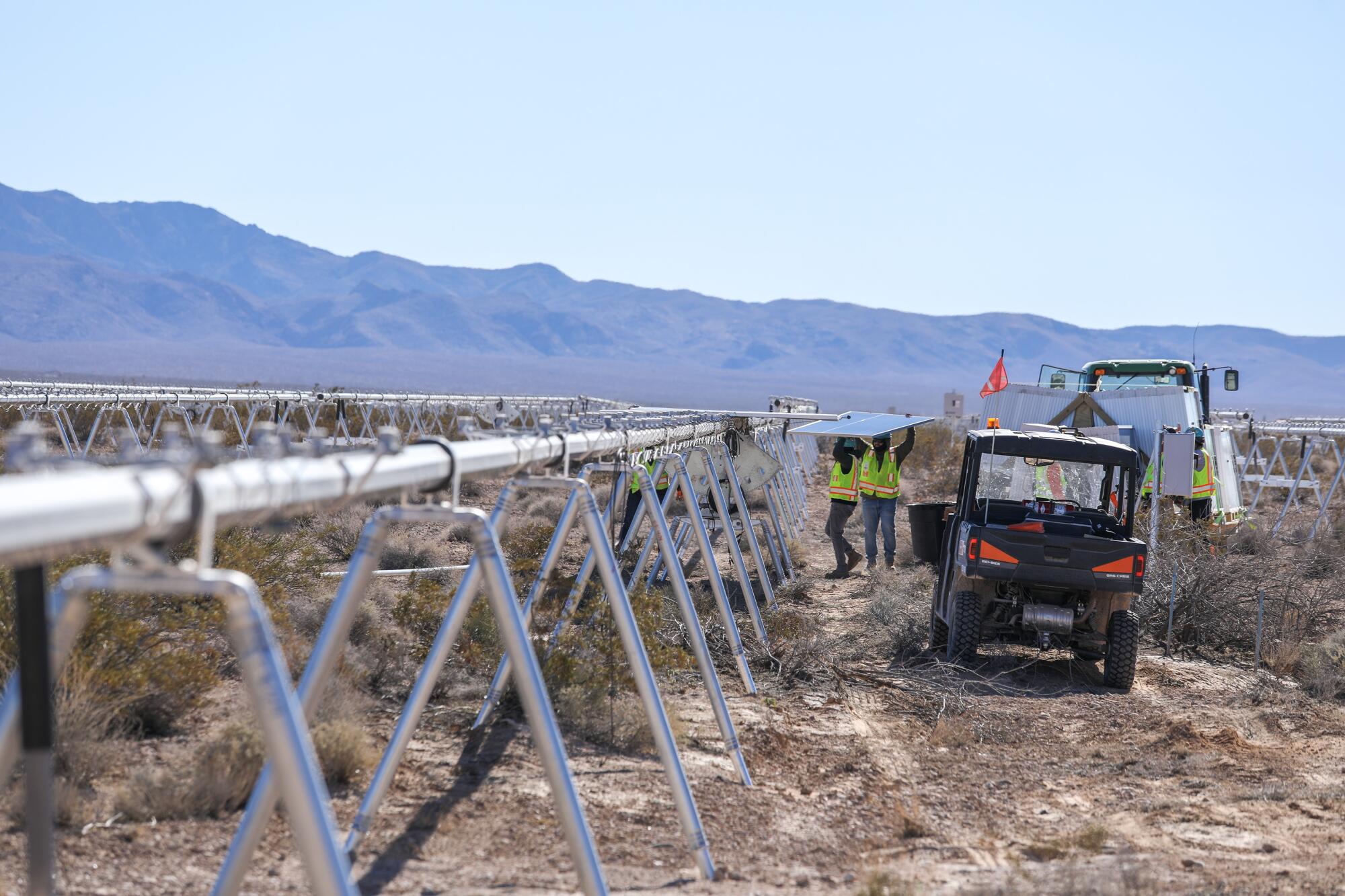
Biologist Bre Moyle easily spotted the small yellow flag affixed to a scraggly creosote bush — one of many hardy plants sprouting from the caliche soil, surrounded by rows of gleaming steel trusses that would soon hoist solar panels toward the sky.
Moyle leaned down for a closer look, gently pulling aside branches to reveal a football-sized hole in the ground. It was the entrance to a desert tortoise burrow — one of thousands catalogued by her employer, Primergy Solar, during construction of one of the nation’s largest solar farms on public lands outside Las Vegas.
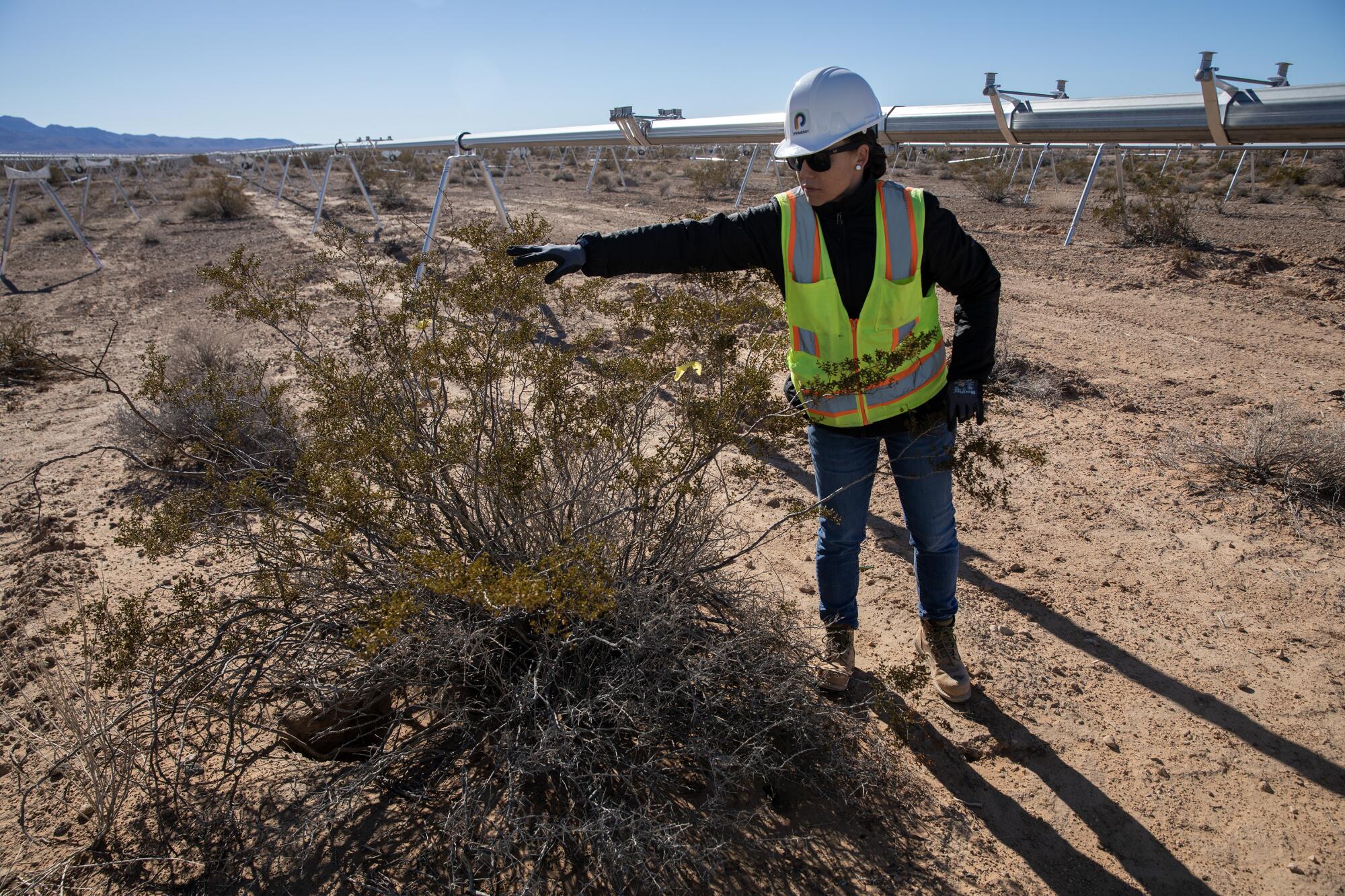
“I wouldn’t stand on this side of it,” Moyle advised us. “If you walk back there, you could collapse it, potentially.”
I’d seen plenty of solar construction sites in my decade reporting on energy. But none like this.
Instead of tearing out every cactus and other plant and leveling the land flat — the “blade and grade” method — Primergy had left much of the native vegetation in place and installed trusses of different heights to match the ground’s natural contours. The company had temporarily relocated more than 1,600 plants to an on-site nursery, with plans to put them back later.
The Oakland-based developer also went to great lengths to safeguard desert tortoises — an iconic reptile protected under the federal Endangered Species Act, and the biggest environmental roadblock to building solar in the Mojave.
Desert tortoises are sensitive to global warming, residential sprawl and other human encroachment on their habitat. The U.S. Fish and Wildlife Service has estimated tortoise populations fell by more than one-third between 2004 and 2014.
Scientists consider much of the Primergy site high-quality tortoise habitat. It also straddles a connectivity corridor that could help the reptiles seek safer haven as hotter weather and more extreme droughts make their current homes increasingly unlivable.
Before Primergy started building, the company scoured the site and removed 167 tortoises, with plans to let them return and live among the solar panels once the heavy lifting is over. Two-thirds of the project site will be repopulated with tortoises.
Workers removed more tortoises during construction. As of January, the company knew of just two tortoises killed — one that may have been hit by a car, and another that may have been entombed in its burrow by roadwork, then eaten by a kit fox.
Primergy Vice President Thomas Regenhard acknowledged the company can’t build solar here without doing any harm to the ecosystem — or spurring opposition from conservation activists. But as he watched union construction workers lift panels onto trusses, he said Primergy is “making the best of the worst-case situation” for solar opponents.
“What we’re trying to do is make it the least impactful on the environment and natural resources,” he said. “What we’re also doing is we’re sharing that knowledge, so that these projects can be built in a better way moving forward.”
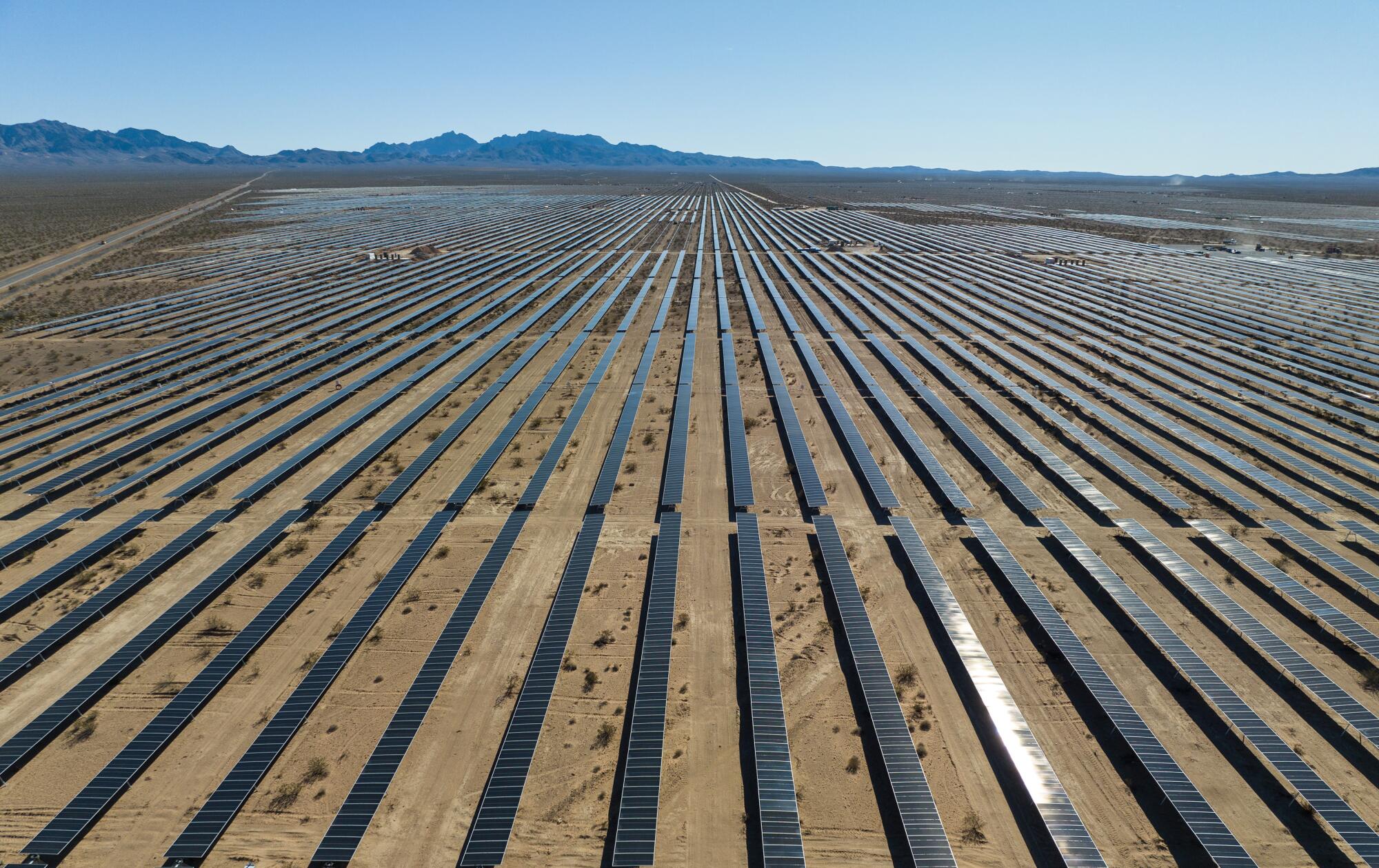
The company isn’t saving tortoises out of the goodness of its profit-seeking heart.
The U.S. Bureau of Land Management conditioned its approval of the solar farm, called Gemini, on a long list of environmental protection measures — and only after some bureau staffers seemingly contemplated rejecting the project entirely.
Documents obtained under the Freedom of Information Act by the conservation group Defenders of Wildlife show the bureau’s Las Vegas field office drafted several versions of a “record of decision” that would have denied the permit application for Gemini. The drafts listed several objections, including harm to desert tortoises, loss of space for off-road vehicle drivers and disturbance of the Old Spanish National Historic Trail, which runs through the project site.
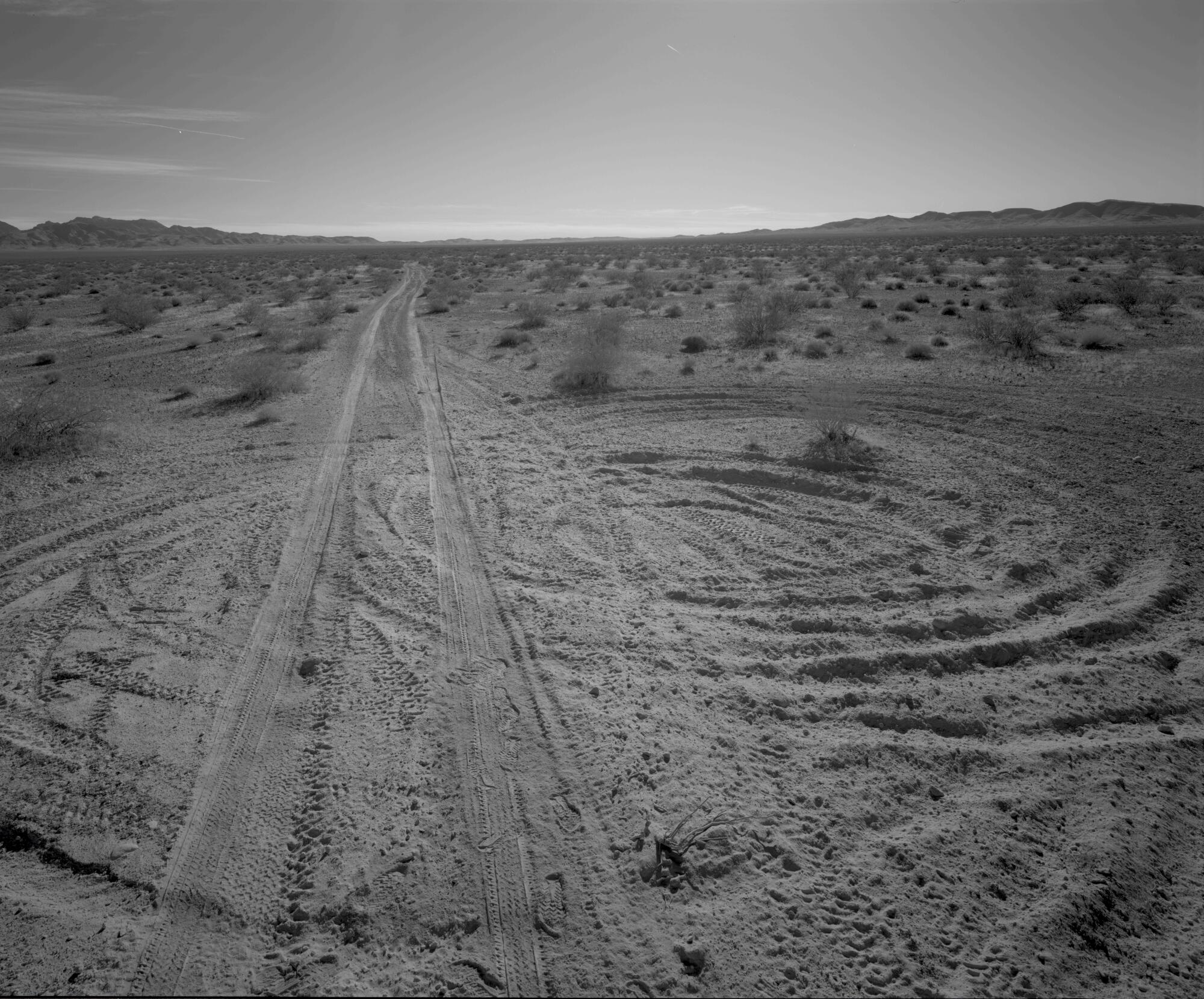
Separately, Primergy reached a legal settlement with conservationists — who challenged the project’s federal approval in court — in which the company agreed to additional steps to protect tortoises and a plant known as the three-corner milkvetch.
The company estimates just 2.5% of the project site will be permanently disturbed — far less than the 33% allowed by Primergy’s federal permit. Regenhard is hopeful the lessons learned here will inform future solar development on public lands.
“This is something new. So we’re refining a lot of the processes,” he said. “We’re not perfect. We’re still learning.”
By the time construction wraps this fall, 1.8 million panels will cover nearly 4,000 football fields’ worth of land, just off the 15 Freeway. They’ll be able to produce 690 megawatts of power — as much as 115,000 typical home solar systems. And they’ll be paired with batteries, to store energy and help NV Energy customers keep running their air conditioners after sundown.
Unlike many solar fields, Gemini is close to the population it will serve — just a few dozen miles from the Strip. And the affected landscape is far from visually stunning, with none of the red-rock majesty found at nearby Valley of Fire State Park.
But desert tortoises don’t care if a place looks cool to humans. They care if it’s good tortoise habitat.
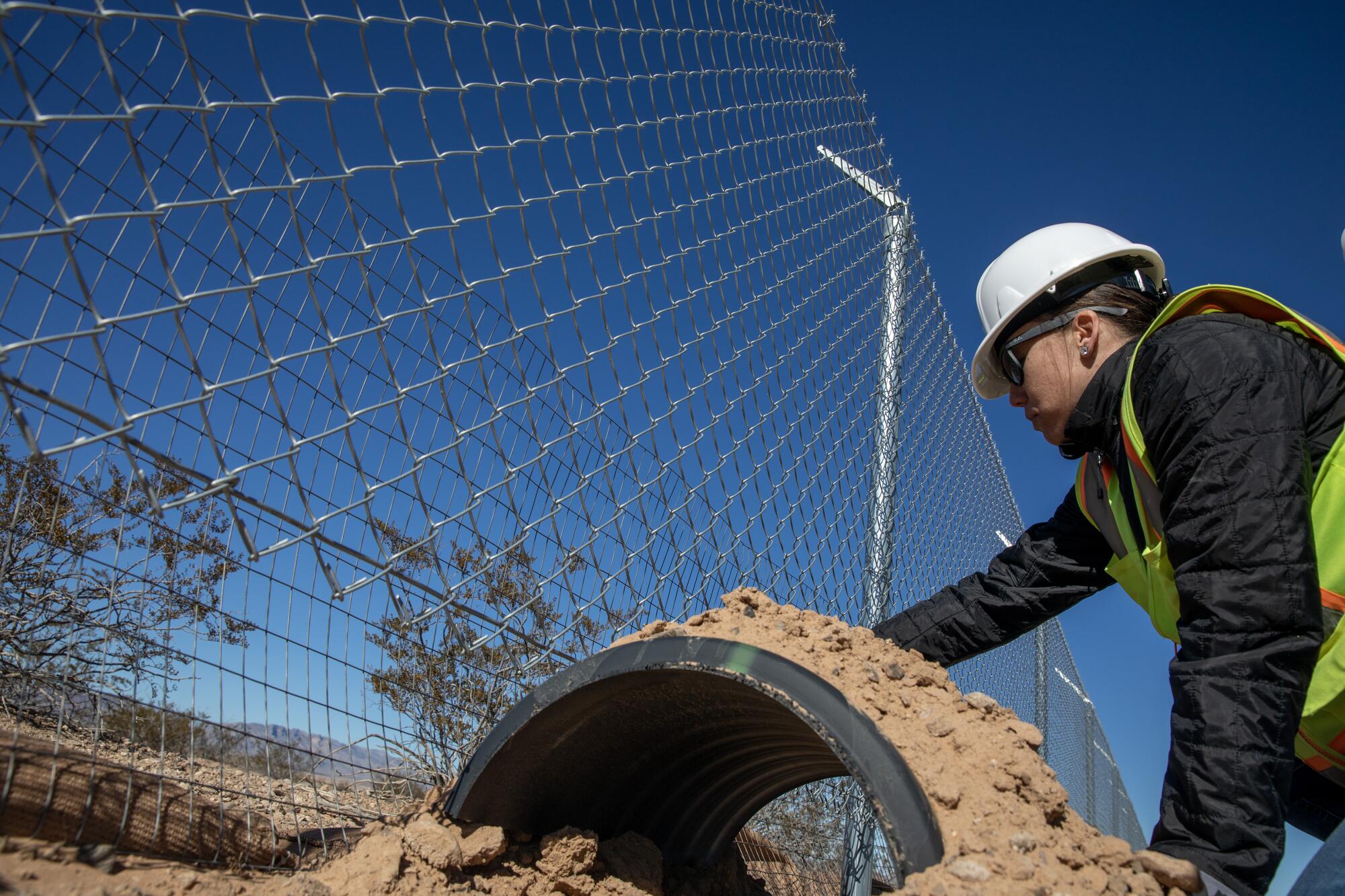
Moyle, Primergy’s environmental services manager, pointed to a small black structure at the bottom of a fence along the site’s edge — a shade shelter for tortoises. Workers installed them every 800 feet, so that if any relocated reptiles try to return to the solar farm too early, they don’t die pacing along the fence in the heat.
“They have a really, really good sense of direction,” Moyle said. “They know where their homes are. They want to come back.”
Primergy will study what happens when tortoises do come back. Will they benefit from the shade of the solar panels? Or will they struggle to survive on the industrialized landscape?
And looming over those uncertainties, a more existential query: With global warming beginning to devastate human and animal life around the world, should we really be slowing or stopping solar development to save a single type of reptile?
Stay tuned for more Repowering the West
Get our Boiling Point newsletter for the next installment in this series — and behind-the-scenes stories.
You may occasionally receive promotional content from the Los Angeles Times.
Moyle was ready with an answer: Tortoises are a keystone species. If they’re doing well, it’s a good sign of a healthy ecosystem in which other desert creatures — such as burrowing owls, kit foxes and American badgers — are positioned to thrive, too.
And as the COVID-19 pandemic has demonstrated, human survival is inextricably linked with a healthy natural world.
“We take one thing out, we don’t know what sort of disastrous effect it’s going to have on everything else,” Moyle said.
We do, however, know the consequences of relying on fossil fuels: entire towns burning to the ground, Lake Mead three-quarters empty, elderly Americans baking to death in their overheated homes. With worse to come.

The shifting sands of time
A few miles south, another solar project was rising in the desert. This one looked different.
A fleet of bulldozers, scrapers, excavators and graders was nearly done flattening the land — a beige moonscape devoid of cacti and creosote. The solar panel support trusses were all the same height, forming an eerily rigid silver sea.
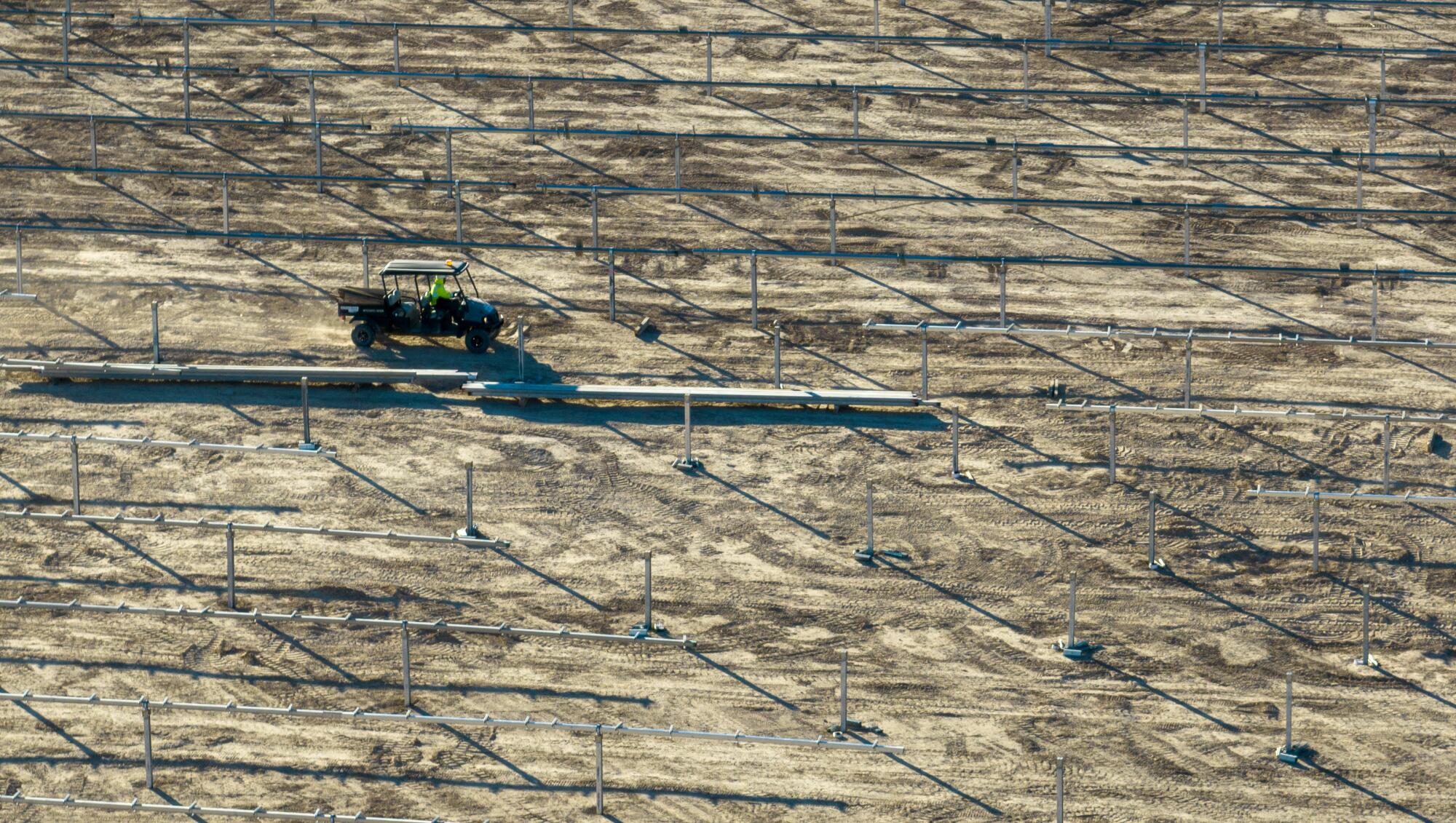
When I asked Carl Glass — construction manager for DEPCOM Power, the contractor building this project for Buffett’s NV Energy — why workers couldn’t leave vegetation in place like at Gemini, he offered a simple answer: drainage. Allowing the land to retain its natural contours, he said, would make it difficult to move stormwater off the site during summer monsoons.
Safety was another consideration, said Dani Strain, NV Energy’s senior manager for the project. Blading and grading the land meant workers wouldn’t have to carry solar panels and equipment across ground studded with tripping hazards.
“It’s nicer for the environment not to do it,” Strain said. “But it creates other problems. You can’t have everything.”
This kind of solar project has typified development in the Mojave Desert.
And it helps explain why the Center for Biological Diversity’s Patrick Donnelly has fought so hard to limit that development.
The morning after touring the solar construction sites, we joined Donnelly for a hike up Big Dune, a giant pile of sand covering five square miles and towering 500 feet above the desert floor, 90 miles northwest of Las Vegas. The sun was just beginning its ascent over the Mojave, bathing the sand in a smooth umber glow beneath pockets of wispy cloud.
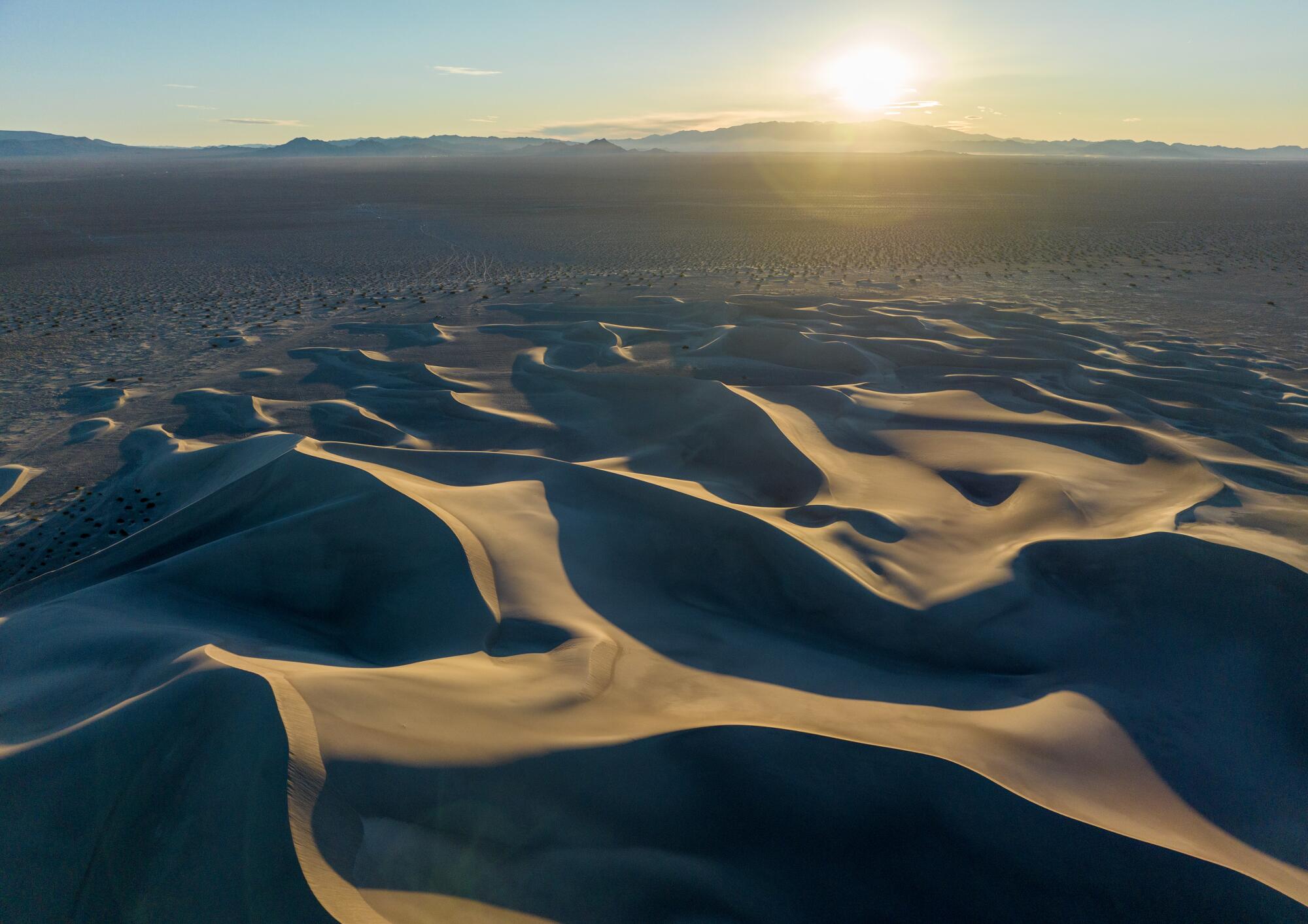
On weekends, Donnelly said, the dune can be overrun by thousands of off-road vehicles. But on this day, it was quiet.
Energy companies have proposed more than a dozen solar farms on public lands surrounding Big Dune — some with overlapping footprints. Donnelly doesn’t oppose all of them. But he thinks federal agencies should limit solar to the least ecologically sensitive parts of Nevada, instead of letting companies pitch projects almost anywhere they choose.
“Developers are looking at this as low-hanging fruit,” he said. “The idea is, this is where California can build all of its solar.”
We trekked slowly up the dune, our bodies casting long shadows in the early morning light. When we took a breather and looked back down, a trail of footprints marked our path. Donnelly assured us a windy day would wipe them away.
“This is why I live here, man,” he said. “It’s the most beautiful place on Earth, in my mind.”
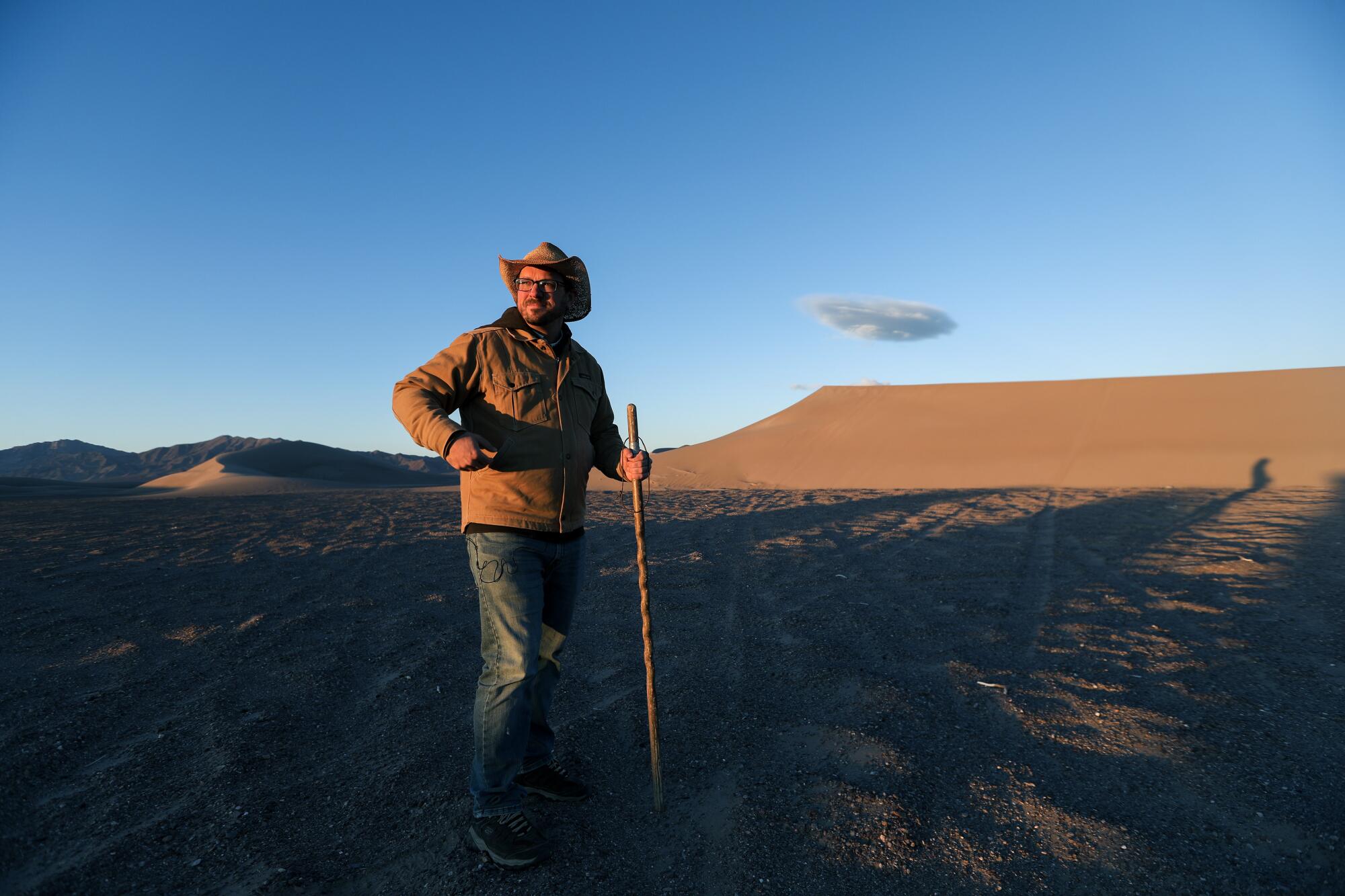
Donnelly broke his back in a rock-climbing accident, so he used a walking stick to scale the dune. He lives not far from here, at the edge of Death Valley National Park, and works as the nonprofit Center for Biological Diversity’s Great Basin director.
As we resumed our journey, the wind blowing hard, I asked Donnelly to rank the top human threats to the Mojave. He was quick to answer: The climate crisis was No. 1, followed by housing sprawl, solar development and off-road vehicles.
“There’s no good solar project in the desert. But there’s less bad,” he said. “And we’re at a point now where we have to settle for less bad, because the alternatives are more bad: more coal, more gas, climate apocalypse.”
That hasn’t stopped Donnelly and his colleagues from fighting renewable energy projects they fear would wipe out entire species — even little-known plants and animals with tiny ranges, such as Tiehm’s buckwheat and the Dixie Valley toad.
“I’m not a religious guy,” Donnelly said. “But all God’s creatures great and small.”
After a steep stretch of sand, we stopped along a ridge with sweeping views. To our west were the Funeral Mountains, across the California state line in Death Valley National Park — and far beyond them Mt. Whitney, its snow-covered facade just barely visible. To our east was Highway 95, cutting across the Amargosa Valley en route from Las Vegas to Reno.
It’s along this highway that so many developers want to build.
“We would be in a sea of solar right now,” Donnelly said.
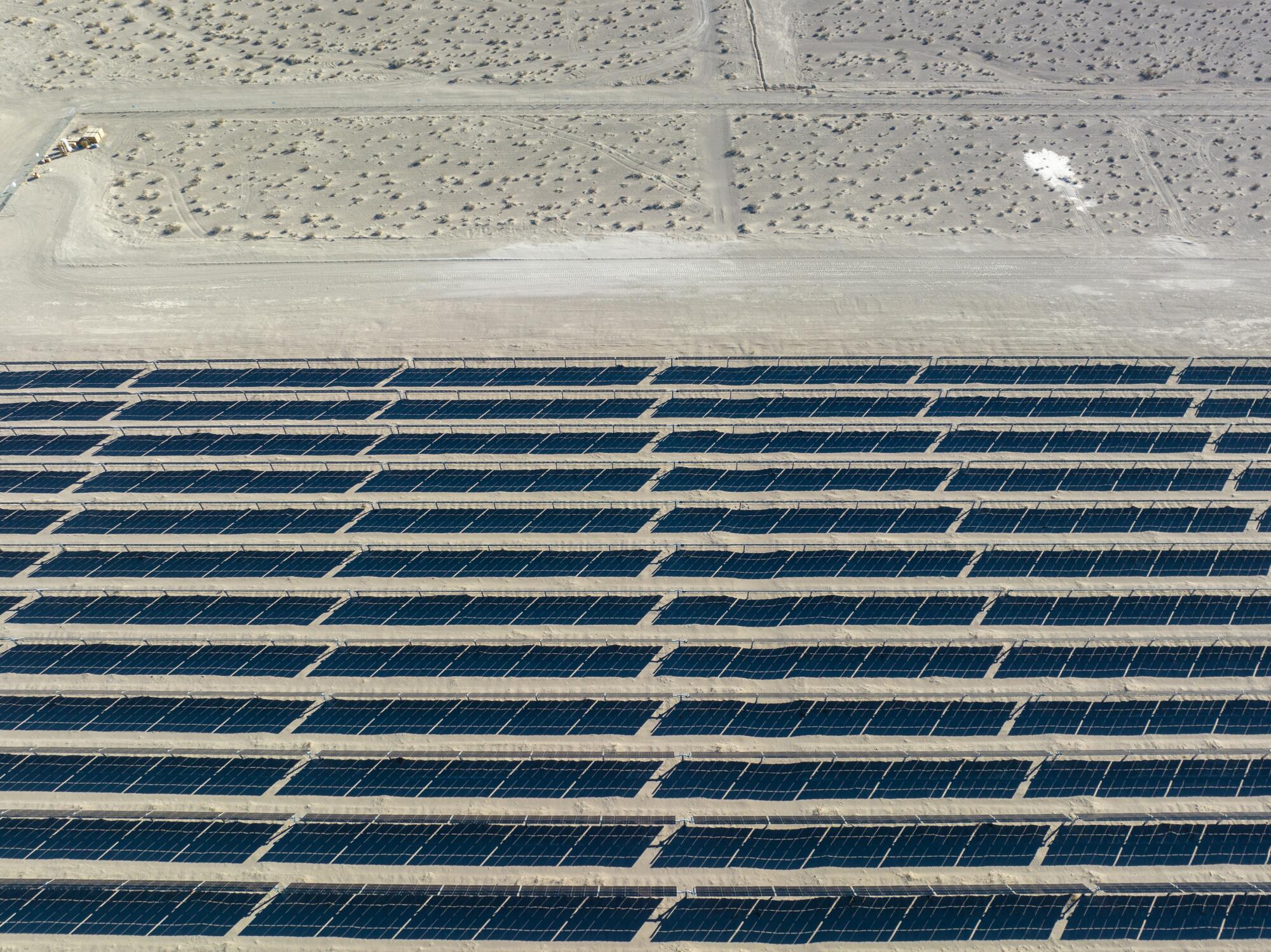
Having heard plenty of rural residents say they don’t want to look at such a sea, I asked Donnelly if this was a bad spot for solar because it would ruin the glorious views. He told me he never makes that argument, “because honestly, views aren’t really the primary concern at this moment. The primary concern is stopping the biodiversity crisis and the climate crisis.”
“There are certain places where we shouldn’t put solar because it’s a wild and undisturbed landscape,” he said.
As far as he’s concerned, though, the Amargosa Valley isn’t one of those landscapes, what with Highway 95 running through it. The same goes for Dry Lake Valley, where NV Energy’s solar construction site is already surrounded by energy infrastructure.
What Donnelly would like to see is better planning.
He pointed to California, where state and federal officials spent eight years crafting a desert conservation plan that allows solar and wind farms across a few hundred thousand acres while setting aside millions more for protection. He thinks a similar process is crucial in Nevada, where four-fifths of the land area is owned by the federal government — more than any other state.
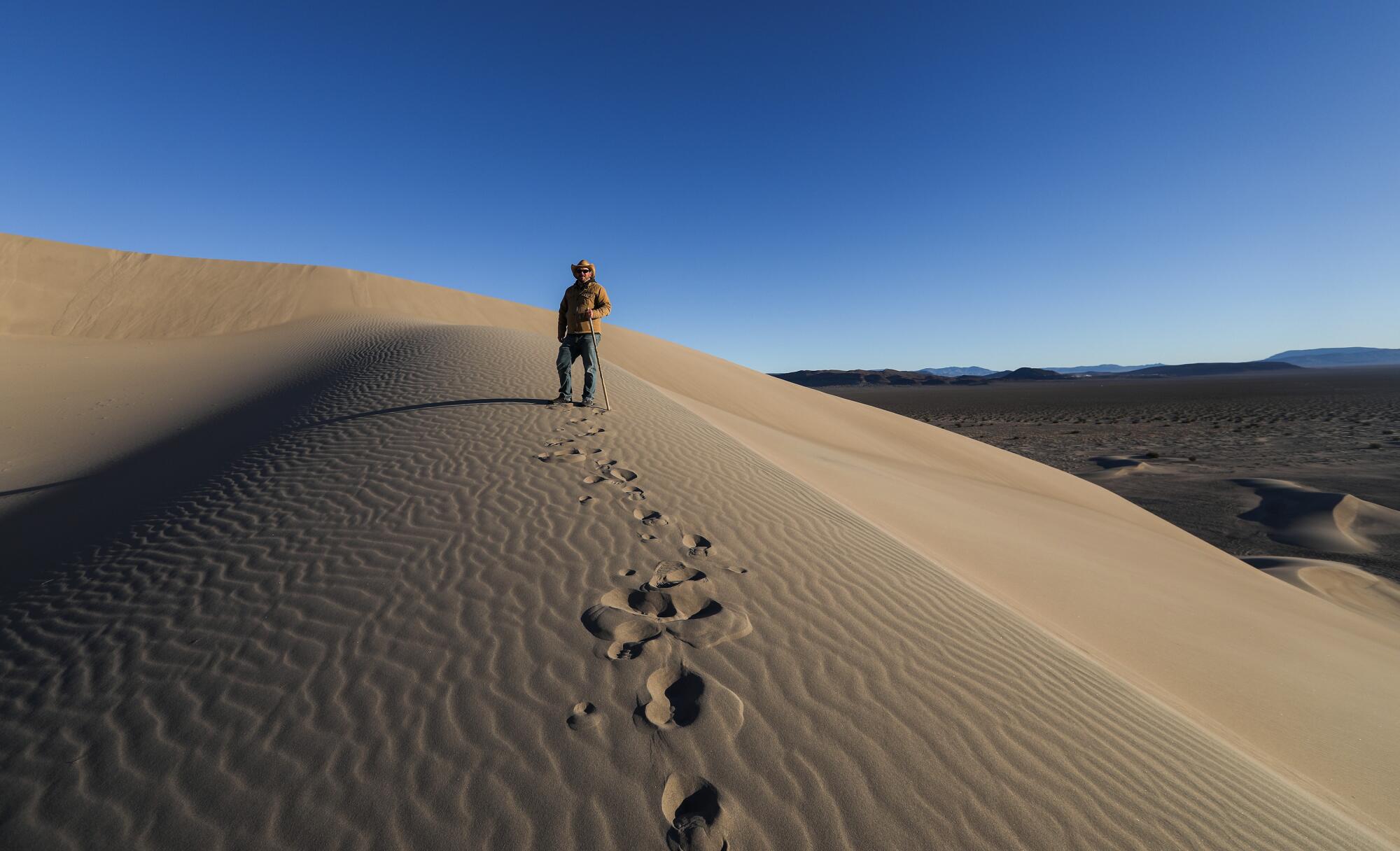
If Donnelly had his way, regulators would put the kibosh on solar farms immediately adjacent to Big Dune. He’s worried they could alter the movement of sand across the desert floor, affecting several rare beetles that call the dune home.
But if the feds want to allow solar projects along the highway to the south, near the Area 51 Alien Center?
“Might not be the end the world,” Donnelly said.
He shot me a grin.
“You know, one thing I like to do ...”
Without warning, he took off racing down the dune, carried by momentum and love for the desert. He laughed as he reached a natural stopping point, calling for us to join him. His voice sounded free and full of possibility.
Some solar panels on the horizon wouldn’t have changed that.
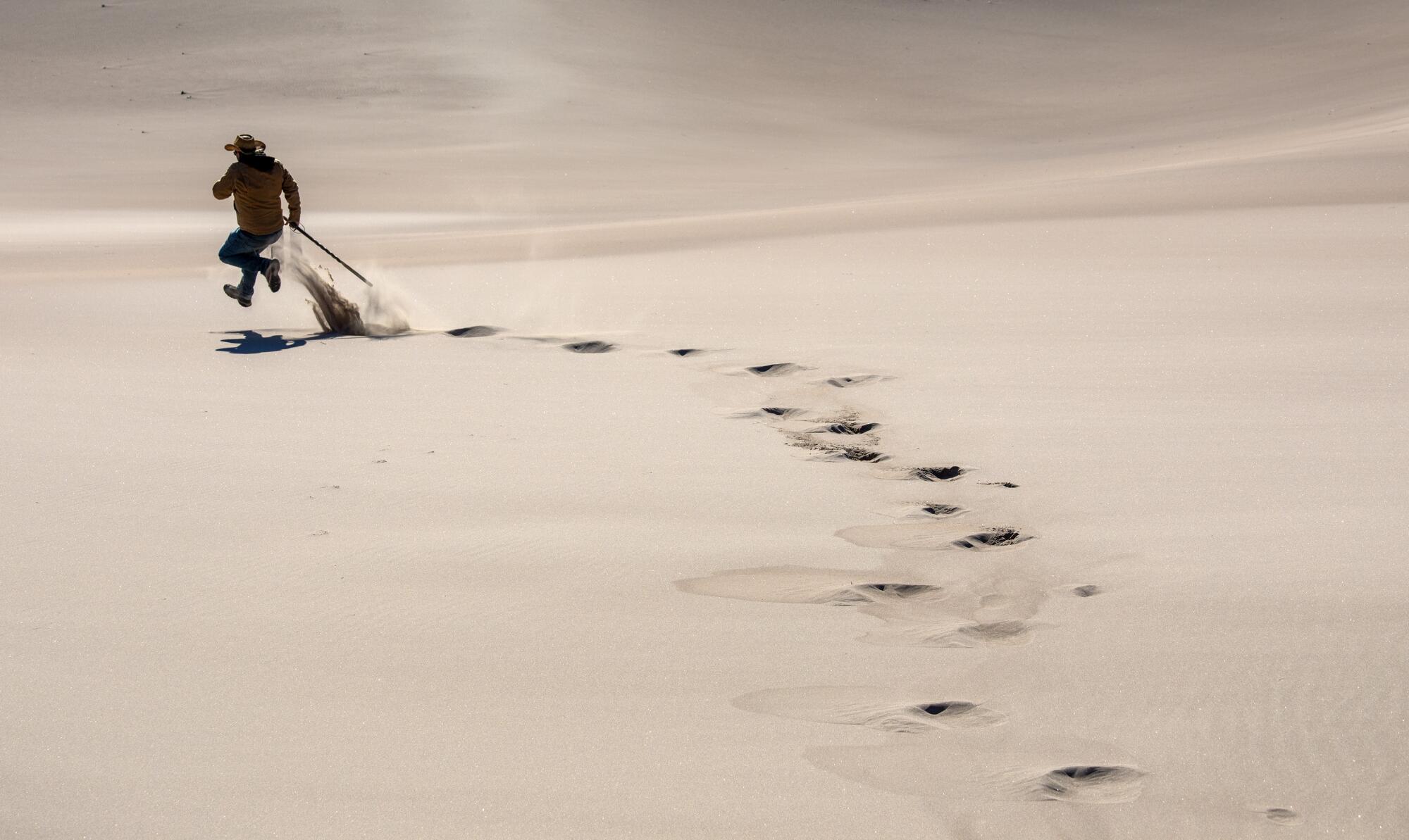

Shout it from the rooftops
Laura Cunningham and Kevin Emmerich were a match made in Mojave Desert heaven.
Cunningham was a wildlife biologist, Emmerich a park ranger when they met nearly 30 years ago at Death Valley. She studied tortoises for government agencies and later a private contractor. He worked with bighorn sheep and gave interpretive talks. They got married, bought property along the Amargosa River and started their own conservation group, Basin and Range Watch.
And they’ve been fighting solar development ever since.
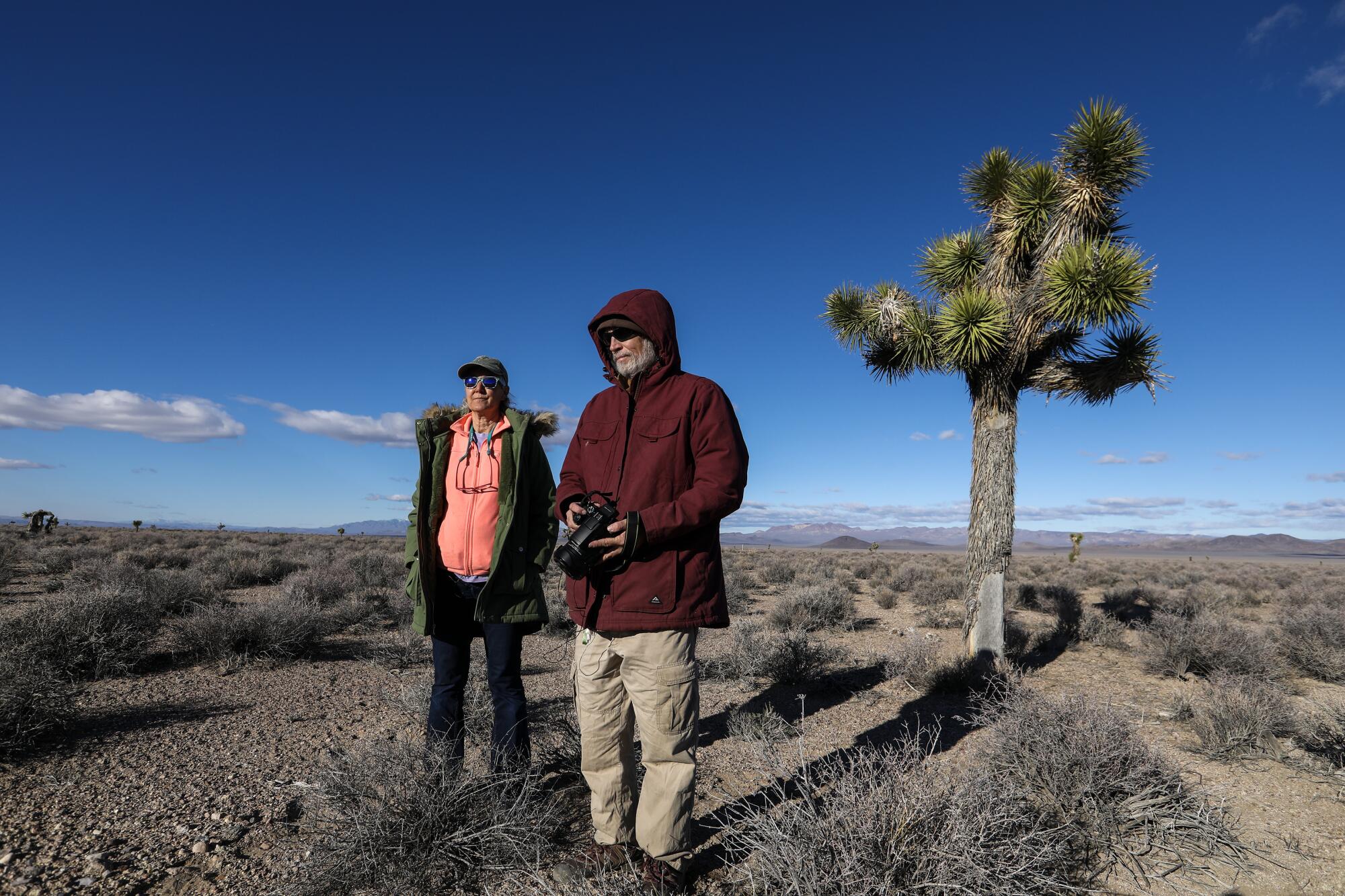
That’s how we ended up in the back of their SUV, pulling open a rickety cattle gate off Highway 95 and driving past wild burros on a dirt road through Nevada’s Bullfrog Hills, 100 miles northwest of Las Vegas.
They had told us Sarcobatus Flat was stunning, but I was still surprised by how stunning. I got my first look as we crested a ridge. The gently sloping valley spilled down toward Death Valley National Park, whose snowy mountain peaks towered over a landscape dotted with thousands of Joshua trees.
“Everything we’re looking at is proposed for solar development,” Cunningham said.
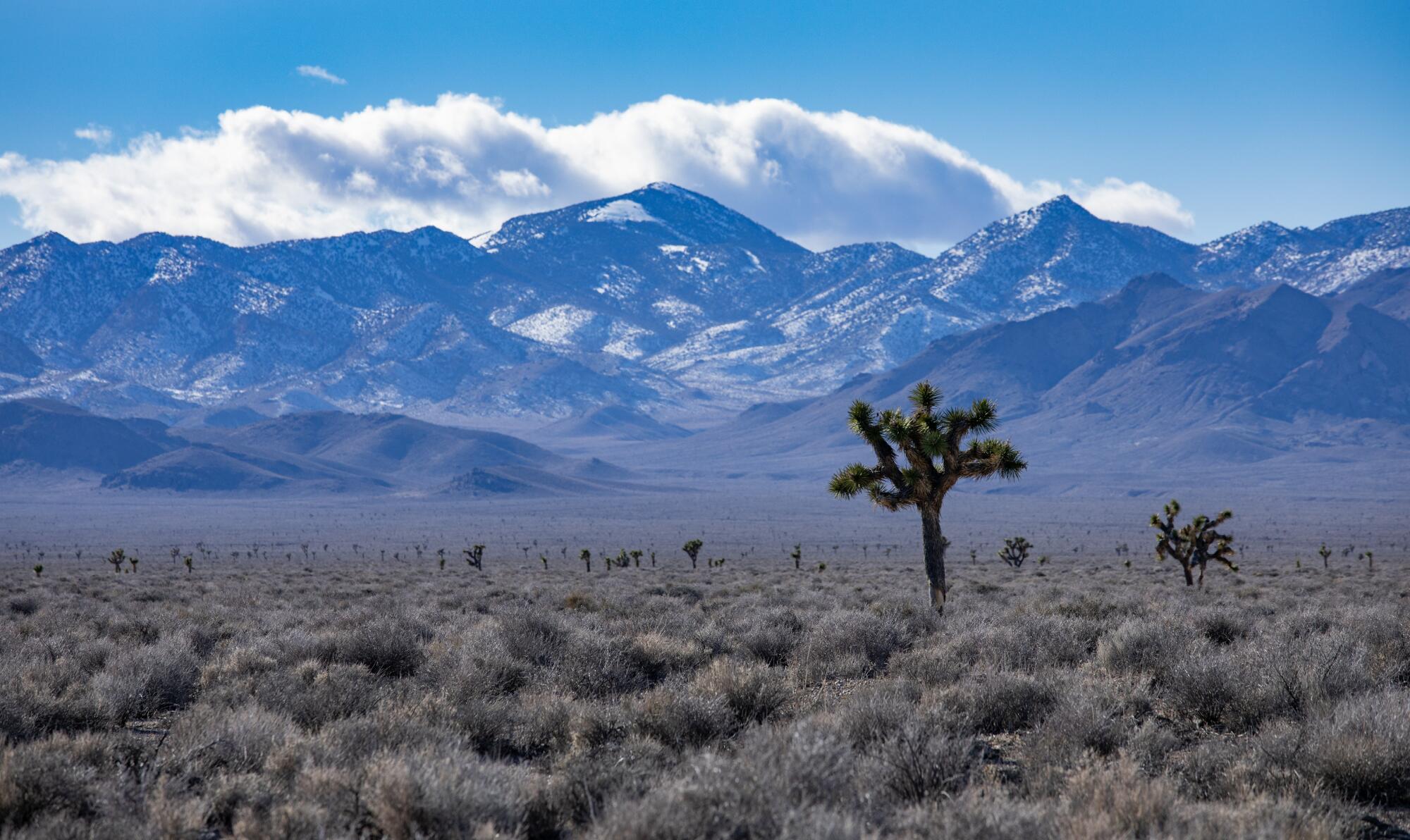
Most environmentalists agree we need at least some large solar farms. Cunningham and Emmerich are different. They’re at the vanguard of a harder-core desert protection movement that sees all large-scale solar farms on public lands as bad news.
Why had so many companies converged on Sarcobatus Flat?
The main answer is transmission. NV Energy is seeking federal approval to build the 358-mile Greenlink West electric line, which would carry thousands of megawatts of renewable power between Reno and Las Vegas along the Highway 95 corridor.
The dirt road curved around a small hill, and suddenly we found ourselves on the valley floor, surrounded by Joshua trees. Some looked healthy; others had bark that had been chewed by rodents seeking water, a sign of drought stress. Scientists estimate the Joshua tree’s western subspecies could lose 90% of its range as the world gets hotter and droughts get more intense.
But asked whether climate change or solar posed a bigger threat to Sarcobatus Flat, Cunningham didn’t hesitate.
“Oh, solar development hands down,” she said.
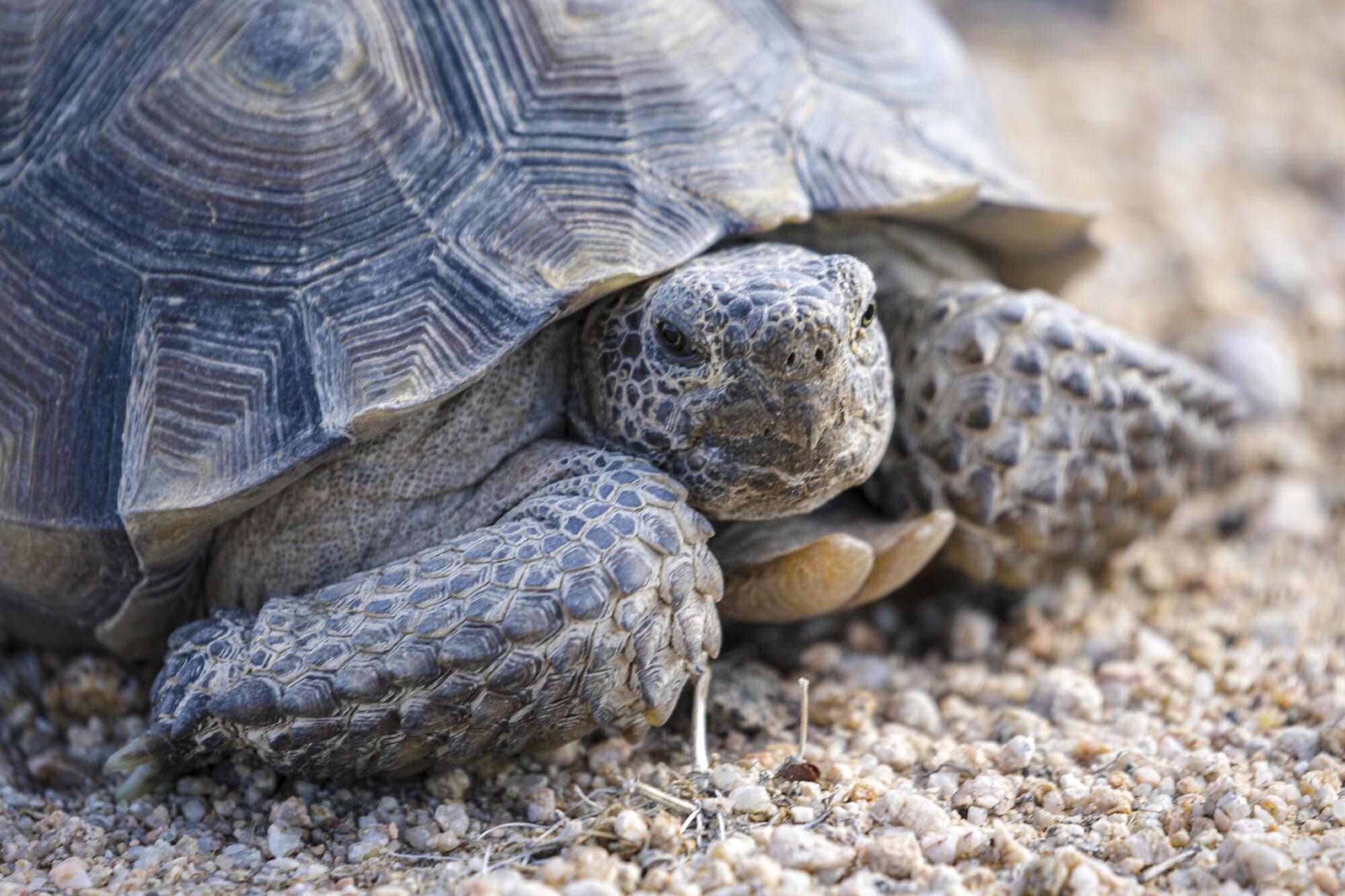
Nearly 20 years ago, she said, she helped relocate desert tortoises to make way for a test track in California. One of them tried to return home, walking 20 miles before hitting a fence. It paced back and forth and eventually died of heat exhaustion.
Solar farms, she said, pose a similar threat to tortoises. And at Sarcobatus Flat, they would cover a high-elevation area that could otherwise serve as a climate refuge for Joshua trees, giving them a relatively cool place to reproduce as the planet heats up.
“It makes no sense to me that we’re going to bulldoze them down and throw them into trash piles. It’s just crazy,” she said.
In Cunningham and Emmerich’s view, every sun-baked parking lot in L.A. and Vegas and Phoenix should have a solar canopy, every warehouse and single-family home a solar roof. It’s a common argument among desert defenders: Why sacrifice sensitive ecosystems when there’s an easy alternative for fighting climate change? Especially when rooftop solar can reduce strain on an overtaxed electric grid and — when paired with batteries — help people keep their lights on during blackouts?
The answer isn’t especially satisfying to conservationists.
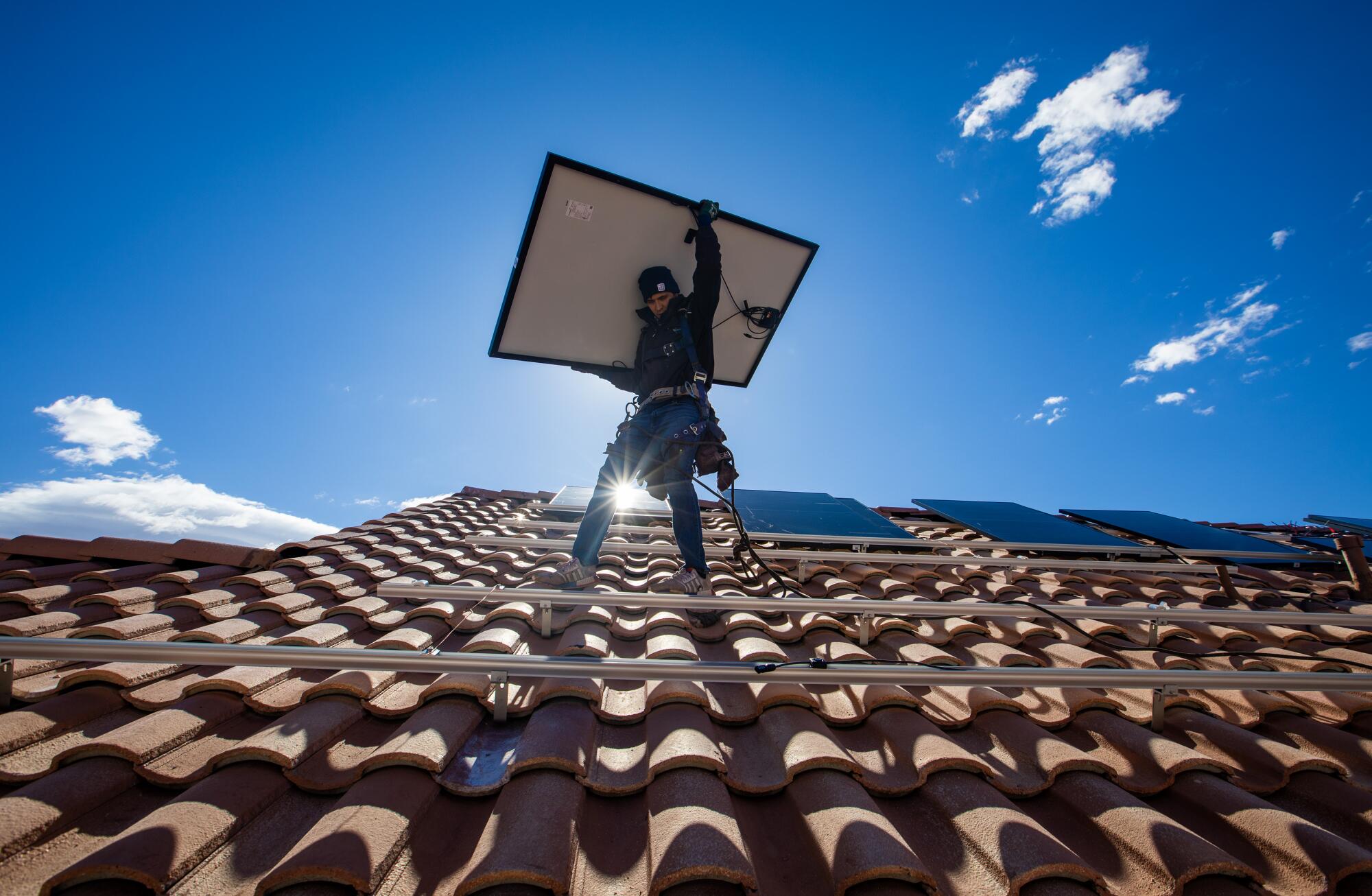
For all the virtues of rooftop solar, it’s an expensive way to generate clean power — and keeping energy costs low is crucial to ensure that lower-income families can afford electric cars, another key climate solution. A recent report from investment bank Lazard pegged the cost of rooftop solar at 11.7 cents per kilowatt-hour on the low end, compared with 2.4 cents for utility solar.
Even when factoring in pricey long-distance electric lines, utility-scale solar is typically cheaper, several experts told me.
“It’s three to six times more expensive to put solar on your roof than to put it in a large-scale project,” said Jesse Jenkins, an energy systems researcher at Princeton University. “There may be some added value to having solar in the Los Angeles Basin instead of the middle of the Mojave Desert. But is it 300% to 600% more value? Probably not. It’s probably not even close.”
There’s a practical challenge, too.
The National Renewable Energy Laboratory has estimated U.S. rooftops could generate 1,432 terawatt-hours of electricity per year — just 13% of the power America will need to replace most of its coal, oil and gas, according to research led by Jenkins.
Add in parking lots and other areas within cities, and urban solar systems might conceivably supply one-quarter or even one-third of U.S. power, several experts told The Times — in an unlikely scenario where they’re installed in every suitable spot.
Energy researcher Chris Clack’s consulting firm has found that dramatic growth in rooftop and other small-scale solar installations could reduce the costs of slashing climate pollution by half a trillion dollars. But even Clack said rooftops alone won’t cut it.
“Realistically, 80% is going to end up being utility grid no matter what,” he said.
All those industrial renewable energy projects will have to go somewhere.
Sarcobatus Flat may not be the answer. Federal officials classified all three solar proposals there as “low priority,” citing their proximity to Death Valley and potential harm to tortoise habitat. One developer withdrew its application last year.
Before leaving the area, Cunningham pointed to a wooden marker, one of at least half a dozen stretching out in a line. I walked over to take a closer look and discovered it was a mining claim for lithium — a main ingredient in electric-car batteries.
If solar development didn’t upend this valley, lithium extraction might.

On the beaten track
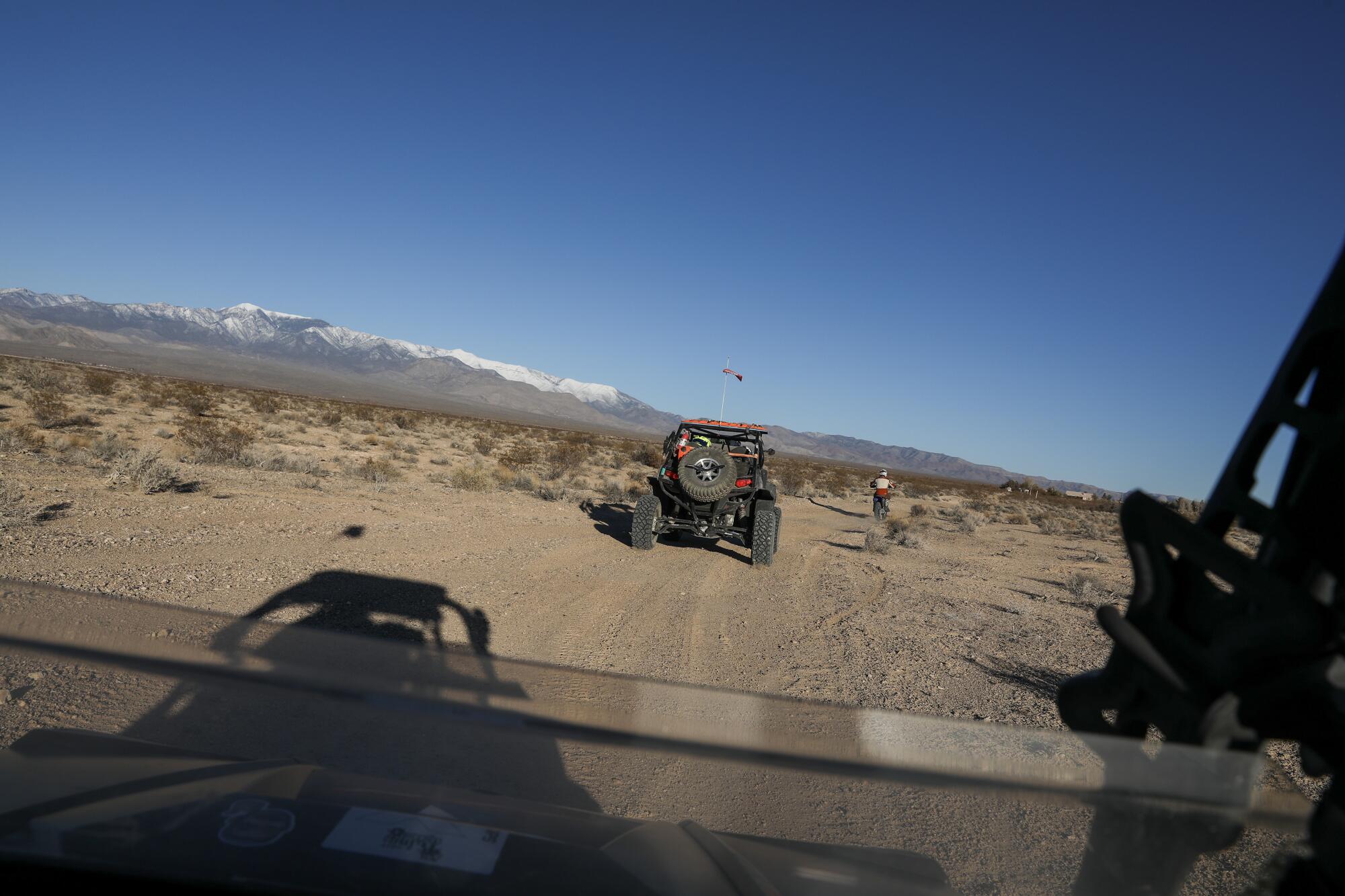
The four-wheeler jerked violently as Erica Muxlow pressed her foot to the gas, sending us flying down a rough dirt road with no end in sight but the distant mountains. Five-point safety straps were the only things stopping us from flying out of our seats, the vehicle leaping through the air as we reached speeds of 40 mph, then 50 mph, the wind whipping our faces.
It was like riding Disneyland’s Matterhorn Bobsleds — just without the Yeti.
Ahead of us, Muxlow’s neighbor Jimmy Lewis led the way on an electric blue motorcycle, kicking up a stream of sand. He wanted us to see thousands of acres of public lands outside his adopted hometown of Pahrump, in Nevada’s Nye County, that could soon be blocked by solar projects — cutting off access to off-highway vehicle enthusiasts such as himself.
“You could build an apartment complex or a shopping mall here, and it would be the same thing to me,” he said.

To progressive-minded Angelenos or San Franciscans, preserving large chunks of public land for gas-guzzling, environmentally destructive dirt bikes might sound like a terrible reason not to build solar farms that would lessen the climate crisis.
But here’s the reality: Rural Westerners such as Lewis will play a key role in determining how much clean energy gets built.
Not long before our Nevada trip, Nye County placed a six-month pause on new renewable energy projects, citing local concerns about loss of off-road vehicle trails. Similar fears have stymied development across the U.S., with rural residents attacking solar and wind farms as industrial intrusions on their way of life — and local governments throwing up roadblocks.
For Lewis, the conflict is deeply personal.
He moved here from Southern California more than a decade ago, trading life by the beach for a five-acre plot where he runs an off-roading school and test-drives motorcycles for manufacturers. His warehouse was packed with dozens of dirt bikes.
“This is my life. Motorcycles, motorcycles, motorcycles,” he said, laughing.
Lewis has worked to stir up opposition to three local solar farm proposals. So far, his efforts have been in vain.

One project is already under construction. Peering through a fence, we saw row after row of trusses, waiting for their photovoltaic panels. It’s called Yellow Pine, and it’s being built by Florida-based NextEra Energy to supply power to California.
Lewis learned about Yellow Pine when he was riding one of his favorite trails and was surprised to find it cut off. He compared the experience to riding the best roller-coaster at a theme park, only to have it grind to a halt three-quarters of the way through.
“I don’t want my playground taken away from me,” he said.
“Me neither!” a voice called out from behind us.
We turned and were greeted by Shannon Salter, an activist who had previously spent nine months camping near the Yellow Pine site to protest the habitat destruction. She and Lewis had never met, but they quickly realized they had common cause.
“It’s the opposite of green!” Salter said.
“On my roof, not my backyard,” Lewis agreed.
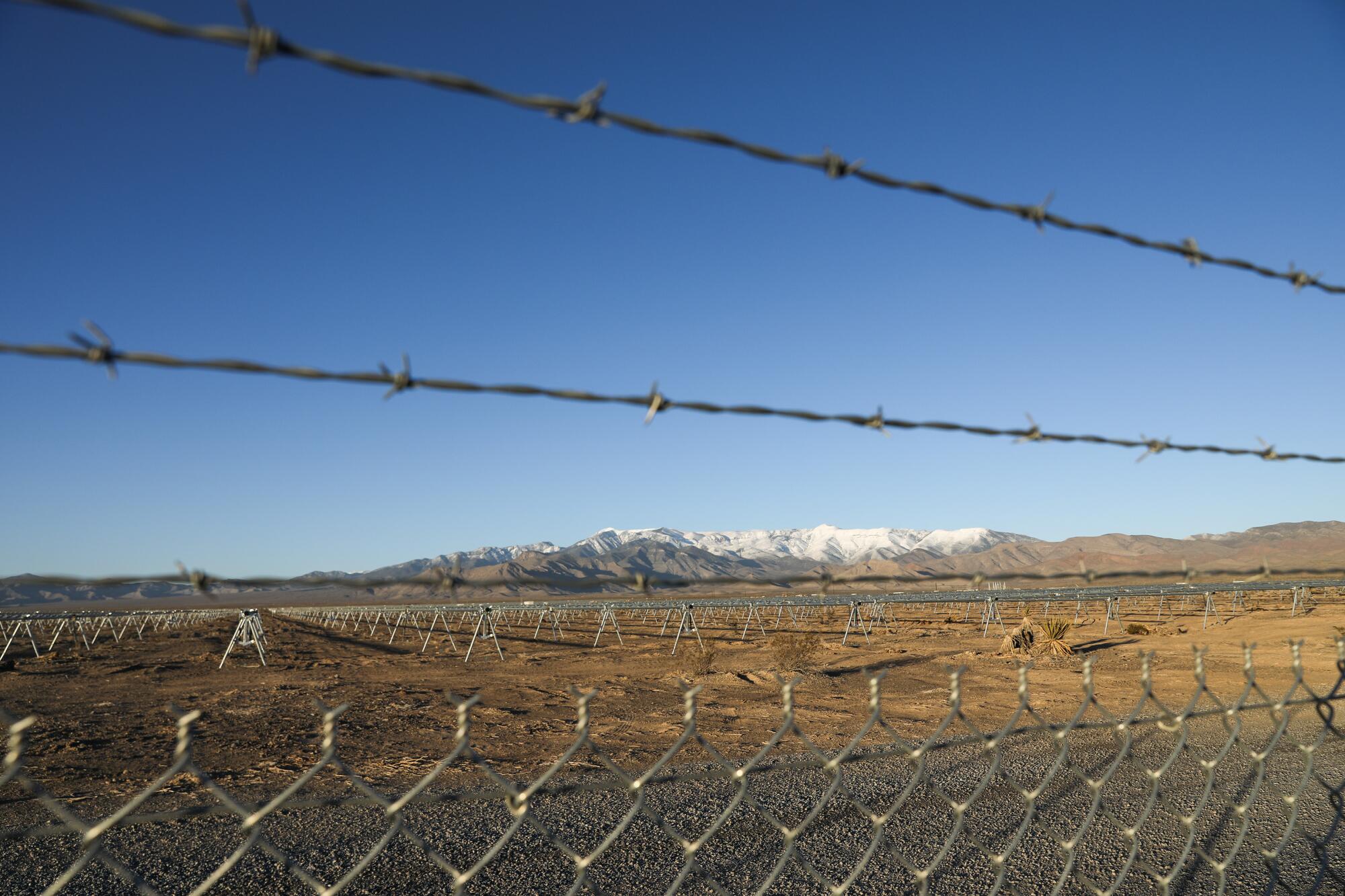
Never mind that conservationists have long decried the ecological damage from desert off-roading. Salter and Lewis both cared about these lands. Neither wanted to see the solar industry lay claim to them. They talked about staying in touch.
It’s easy to imagine similar alliances forming across the West, the clean energy transition bringing together environmentalists and rural residents in a battle to defend their lifestyles, their landscapes and animals that can’t fight for themselves.
Your guide to our clean energy future
Get our Boiling Point newsletter for the latest on the power sector, water wars and more — and what they mean for California.
You may occasionally receive promotional content from the Los Angeles Times.
It’s also easy to imagine major cities that badly need lots of solar and wind power — Los Angeles, Las Vegas, Phoenix — brushing off those complaints as insignificant compared with the climate emergency, or as fueled by right-wing misinformation.
But many of concerns raised by critics are legitimate. And their voices are only getting louder.
As night fell over the Mojave, Lewis shared his idea that any city buying electricity from a desert solar farm should be required to install a certain amount of rooftop solar back home first — on government buildings, at least. It only seemed fair.
“Some people see the desert as just a wasteland,” Lewis said. “I think it’s beautiful.”

The view from Black Mountain
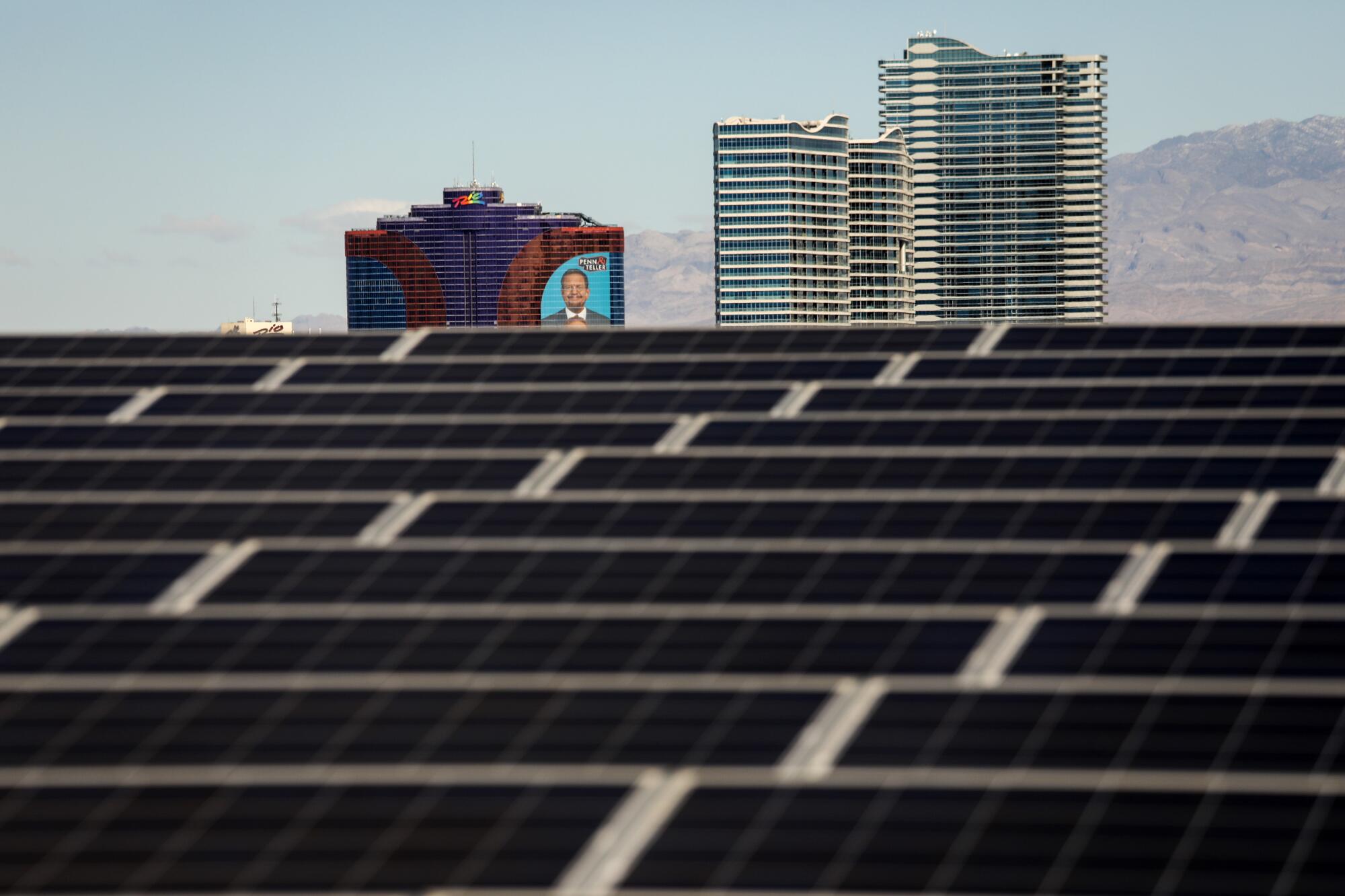
So how do we build enough renewable energy to replace fossil fuels without destroying too many ecosystems, or stoking too much political opposition from rural towns, or moving too slowly to save the planet?
Few people could do more to ease those tensions than Buffett.
Our conversation kept returning to the legendary investor as we hiked Black Mountain, just outside Vegas, on our last morning in the Silver State. We were joined by Jaina Moan, director of external affairs for the Nature Conservancy’s Nevada chapter. She had promised a view of massive solar fields from the peak — but only after a 3.5-mile trek with 2,000 feet of elevation gain.
“It’ll be a little StairMaster at the end,” she warned us.
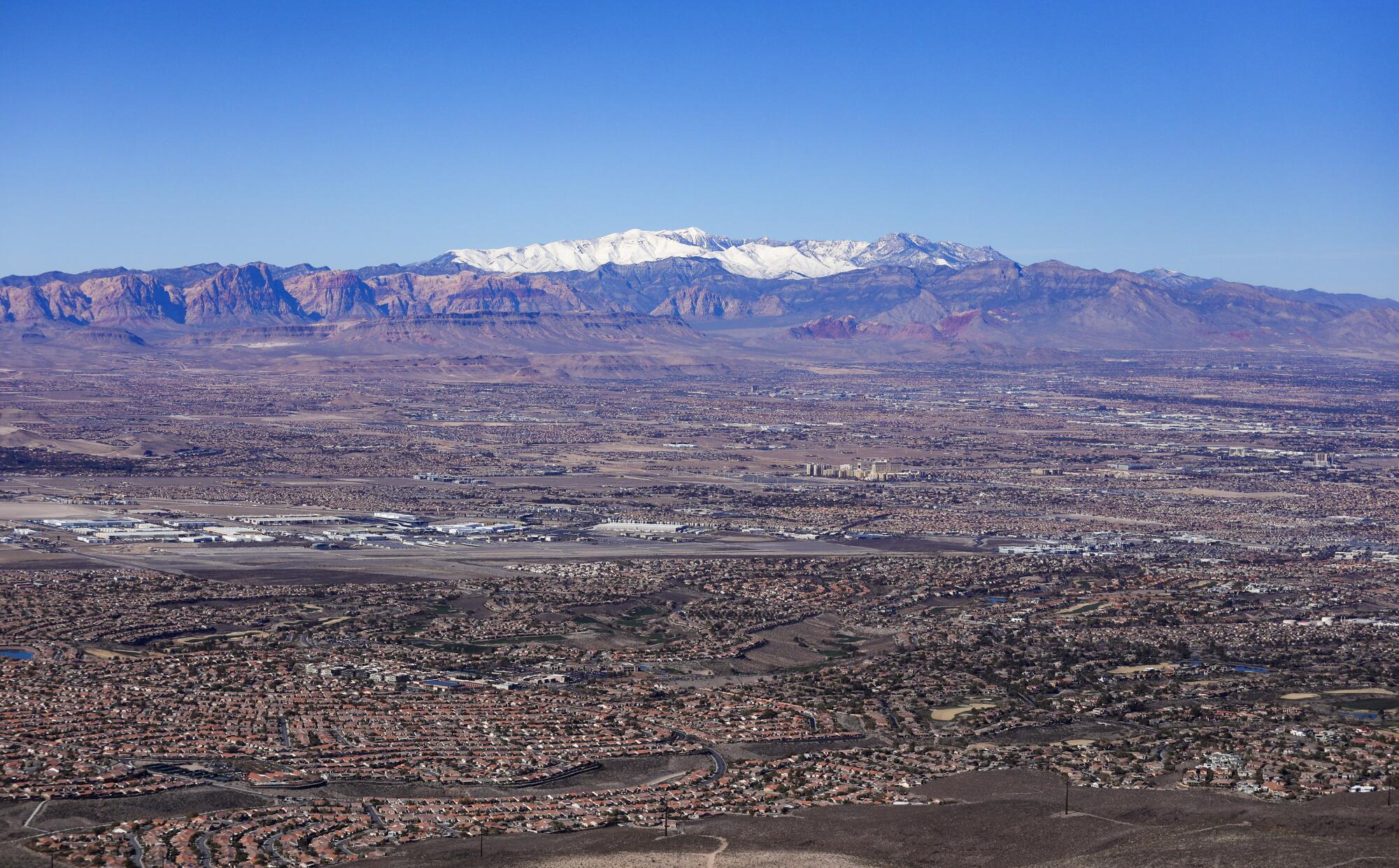
The homes and hotels and casinos of the Las Vegas Valley retreated behind us as we climbed, looking ever smaller and more insignificant against the vast open desert. It was an illusion that will prove increasingly difficult to maintain as Sin City and its suburbs continue their march into the Mojave. Nevada politicians from both parties are pushing for legislation that would let federal officials auction off additional public lands for residential and commercial development.
Vegas and other Western cities could limit the need for more suburbs — and sprawling solar farms — by growing smarter, Moan said. Urban areas could embrace density, to help people drive fewer miles and reduce the demand for new power supplies to fuel electric vehicles. They could invest in electric buses and trains — and use less water, which would save a lot of energy.
“As our spaces become more crowded, we’re going to have to come up with more creative ideas,” Moan said.

That’s where Buffett could make things easier.
The billionaire’s Berkshire Hathaway company owns electric utilities that serve millions of people, from California to Nevada to Illinois. Those utilities, Moan said, could buck the industry trend of urging policymakers to reduce financial incentives for rooftop solar and instead encourage the technology — along with other small-scale clean energy solutions, such as local microgrids.
That would limit the need for big solar farms — at least somewhat.
Berkshire and other energy giants could also build solar on lands already altered by humans, such as abandoned mines, toxic Superfund sites, reservoirs, landfills, agricultural areas, highway corridors and canals that carry water to farms and cities.
The costs are typically higher than building on undisturbed public lands. And in many cases there are technical challenges yet to be resolved. But those kinds of “creative solutions” could at least lessen the loss of biodiversity, Moan said.
“There’s money to be made there, and there’s good to be done,” she said.
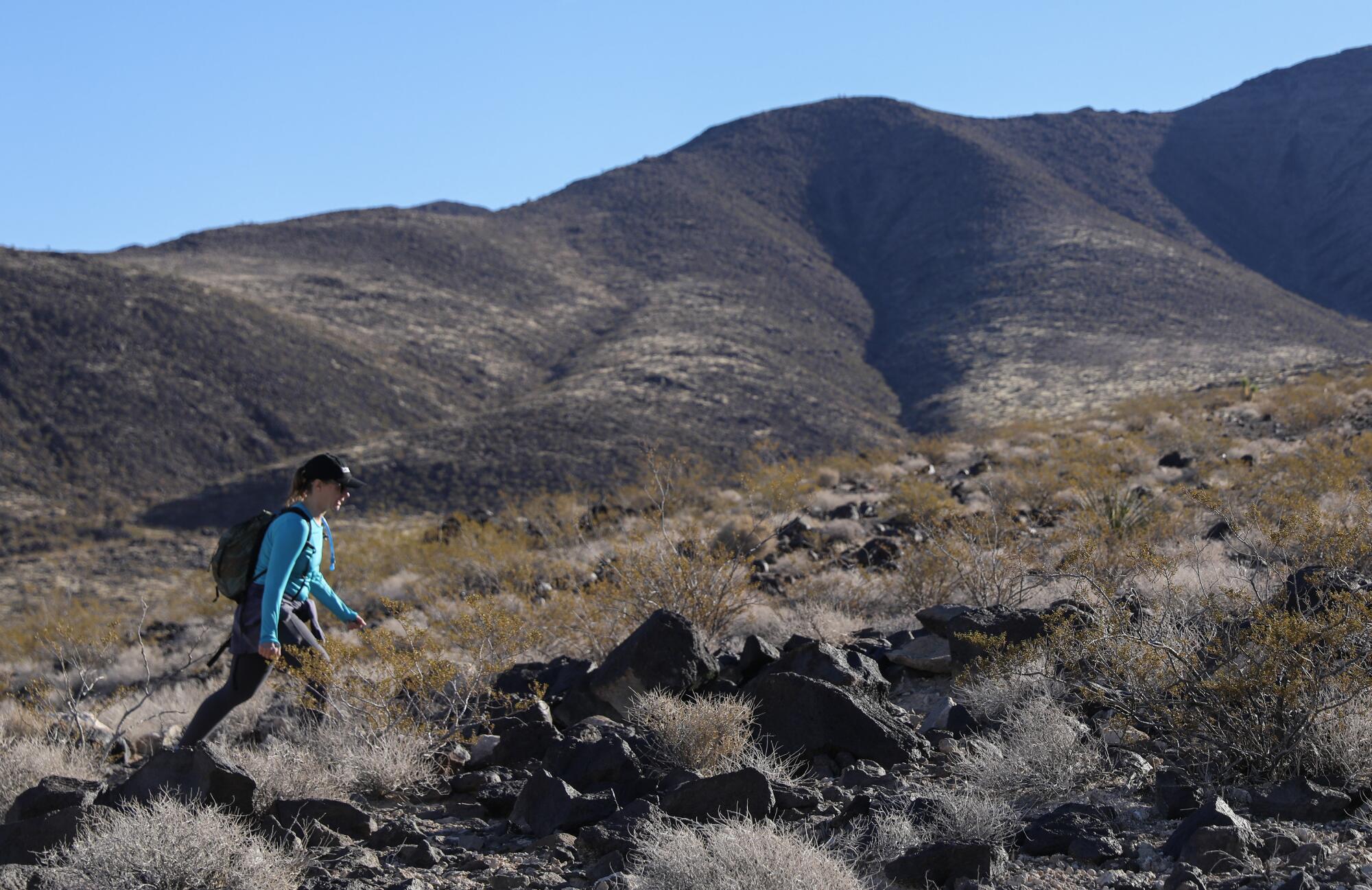
It’s hard to know what Buffett thinks. A Berkshire spokesperson declined my request to interview him.
Tony Sanchez, NV Energy’s executive vice president for business development and external relations, was more forthcoming.
“The problem for us with rooftop solar,” he said, is that it’s “not controlled at all by us.” As a result, NV Energy can’t decide when and how rooftop solar power is used — and can’t rely on that power to help balance supply and demand on the grid.
Over time, Sanchez predicted, a lot more rooftop solar will get built. But he couldn’t say how much.
Rooftop solar faces a similarly uncertain future in California, where state officials voted last year to slash incentive payments, calling them an unfair subsidy. Industry leaders have warned of a dramatic decline in installations.
As we neared the top of Black Mountain, the solar farms on the other side came into view. They stretched across the Eldorado Valley far below — black rectangles that could help save life on Earth while also destroying bits and pieces of it.
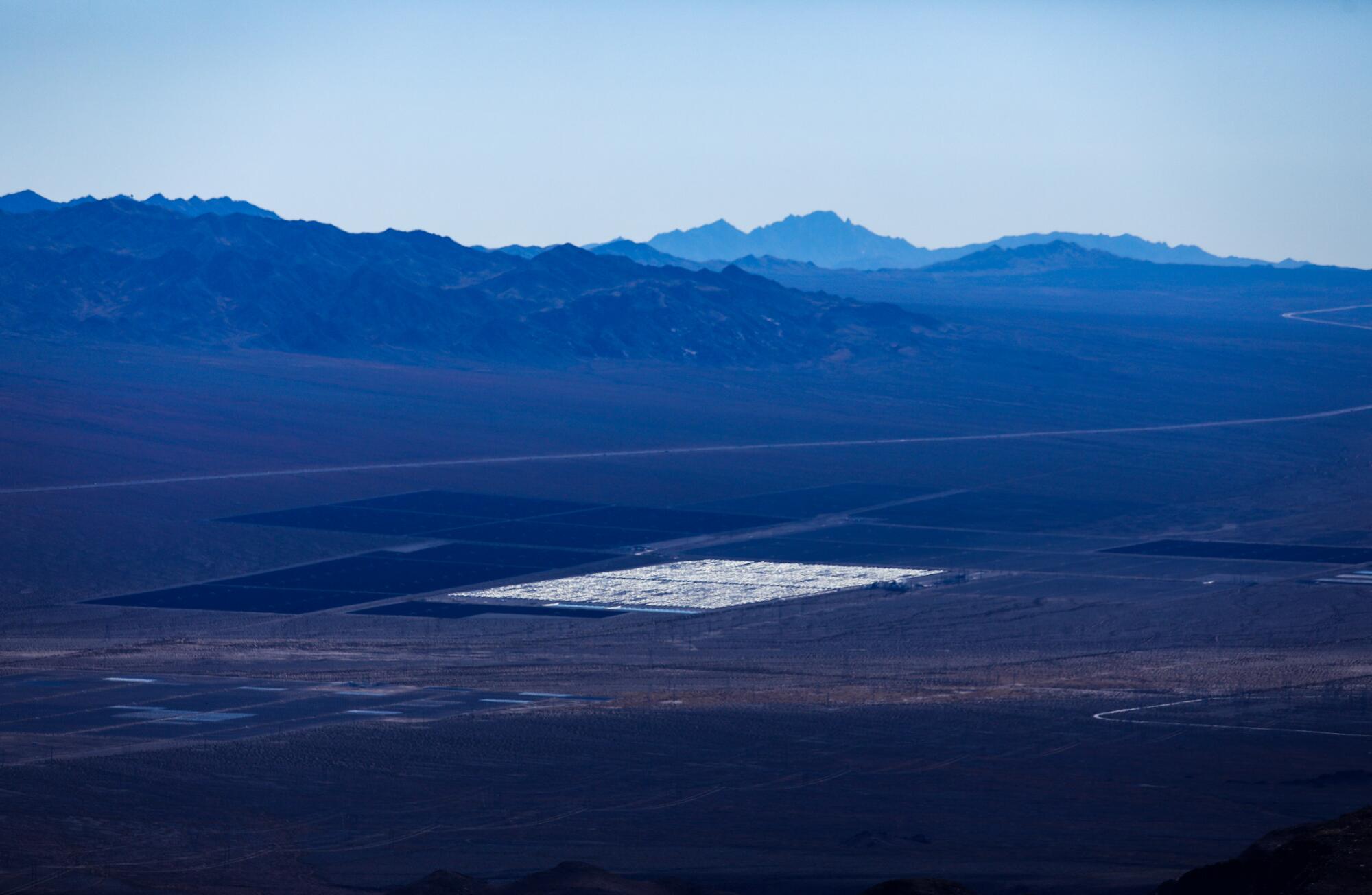
Moan believes the key to balancing clean energy and conservation is “go slow to go fast.” Government agencies, she said, should work with conservation activists, small-town residents and Native American tribes to study and map out the best places for clean energy, then reward companies that agree to build in those areas with faster approvals. Solar and wind development would slow down in the short term but speed up in the long run, with quicker environmental reviews and less risk of lawsuits.
It’s a tantalizing concept — but I confessed to Moan that I worried it would backfire.
What if the sparring factions couldn’t agree on the best spots to build solar and wind farms, and instead wasted years arguing? Or what if they did manage to hammer out some compromises, only for a handful of unhappy people or groups to take them to court, gumming up the works? Couldn’t “go slow to go fast” end up becoming “go slow to go slow”?
In other words, should we really bet our collective future on human beings working together, rather than fighting?
Moan was sympathetic to my fears. She also didn’t see another way forward.
“We really need to think holistically about saving everything,” she said.
The sad truth is, not everything can be saved. Not if we want to keep the world livable for people and animals alike.
Some beloved landscapes will be left unrecognizable. Some families will be stuck paying high energy bills to monopoly utilities, even as some utility investors make less money. Some tortoises will probably die, pacing along fences in the heat.
The alternative is worse.
Support our journalism
Your support helps us deliver the news that matters most. Subscribe to the Los Angeles Times.
